The Impact of Personal, Social and Cultural Factors on Inclusive Learning
VerifiedAdded on 2022/03/03
|18
|6906
|182
AI Summary
Early experiences and the culture of one's environment have an impact on a student's expectations for and approaches to learning. Additionally, a student's academic achievement is highly correlated with learning objectives, cultural norms, interconnections between classroom experiences, etc. Peer pressure is another factor to take into account while creating inclusive policies. If we have a student with great ability, there is a possibility that they may belittle students with lower ability, making them feel inadequate.
Contribute Materials
Your contribution can guide someone’s learning journey. Share your
documents today.

Inclusive practice Assignment
Introduction
In an educational school environment, inclusive practice denotes to a method in which
both normal and handicapped pupils are given appropriate help. Inclusive learning is a
type of education in which special needy students are included in regular classrooms.
1.1The impact of personal, social and cultural factors on learning
A student’s early life experience and his or her surrounding culture influence his or her
learning expectations and processes. In addition, learning expectations cultural values,
and interactions between classroom experiences, etc., are all closely linked to a
student's academic performance
AGE
Under-sensation and perception, weariness and monotony, maturation, emotional
state, needs, interests, and motivation are some of the personal elements that impact
the learning process. However, the memory of young people tends to be quite sharp
which creates conducive conditions for learning. But it should also be noted that their
level of attention may be low in some cases, which may hinder their learning (Schmeck,
2013). Old individuals, in contrast, may not have as keen a recall as young people, but
they have high levels of attention in terms of learning. In case of gender, females pay
greater attention than gentlemen. In addition to linguistics and humanities, women are
stronger than males, while men are stronger in technical disciplines like mathematics.
Studies have shown that girls 'brains grow faster than their boys' peers, which may be
associated with higher attention in girls than in boys (Parks, 2005).
Confidence
High self-confidence might help you comprehend a problem or issue better. But the
more a person's self-confidence, the more crucial his or her knowledge of an issue or
difficulty will be. Thus, comprehending a problem in the classroom through teaching and
learning activities would increase knowledge of the supplied content. On the other
hand, Students with low self-esteem or confidence question their capacity to achieve,
making them unwilling to participate in learning as well as take necessary academic
risks(Parks, 2005) .
Peer pressure
Introduction
In an educational school environment, inclusive practice denotes to a method in which
both normal and handicapped pupils are given appropriate help. Inclusive learning is a
type of education in which special needy students are included in regular classrooms.
1.1The impact of personal, social and cultural factors on learning
A student’s early life experience and his or her surrounding culture influence his or her
learning expectations and processes. In addition, learning expectations cultural values,
and interactions between classroom experiences, etc., are all closely linked to a
student's academic performance
AGE
Under-sensation and perception, weariness and monotony, maturation, emotional
state, needs, interests, and motivation are some of the personal elements that impact
the learning process. However, the memory of young people tends to be quite sharp
which creates conducive conditions for learning. But it should also be noted that their
level of attention may be low in some cases, which may hinder their learning (Schmeck,
2013). Old individuals, in contrast, may not have as keen a recall as young people, but
they have high levels of attention in terms of learning. In case of gender, females pay
greater attention than gentlemen. In addition to linguistics and humanities, women are
stronger than males, while men are stronger in technical disciplines like mathematics.
Studies have shown that girls 'brains grow faster than their boys' peers, which may be
associated with higher attention in girls than in boys (Parks, 2005).
Confidence
High self-confidence might help you comprehend a problem or issue better. But the
more a person's self-confidence, the more crucial his or her knowledge of an issue or
difficulty will be. Thus, comprehending a problem in the classroom through teaching and
learning activities would increase knowledge of the supplied content. On the other
hand, Students with low self-esteem or confidence question their capacity to achieve,
making them unwilling to participate in learning as well as take necessary academic
risks(Parks, 2005) .
Peer pressure
Secure Best Marks with AI Grader
Need help grading? Try our AI Grader for instant feedback on your assignments.
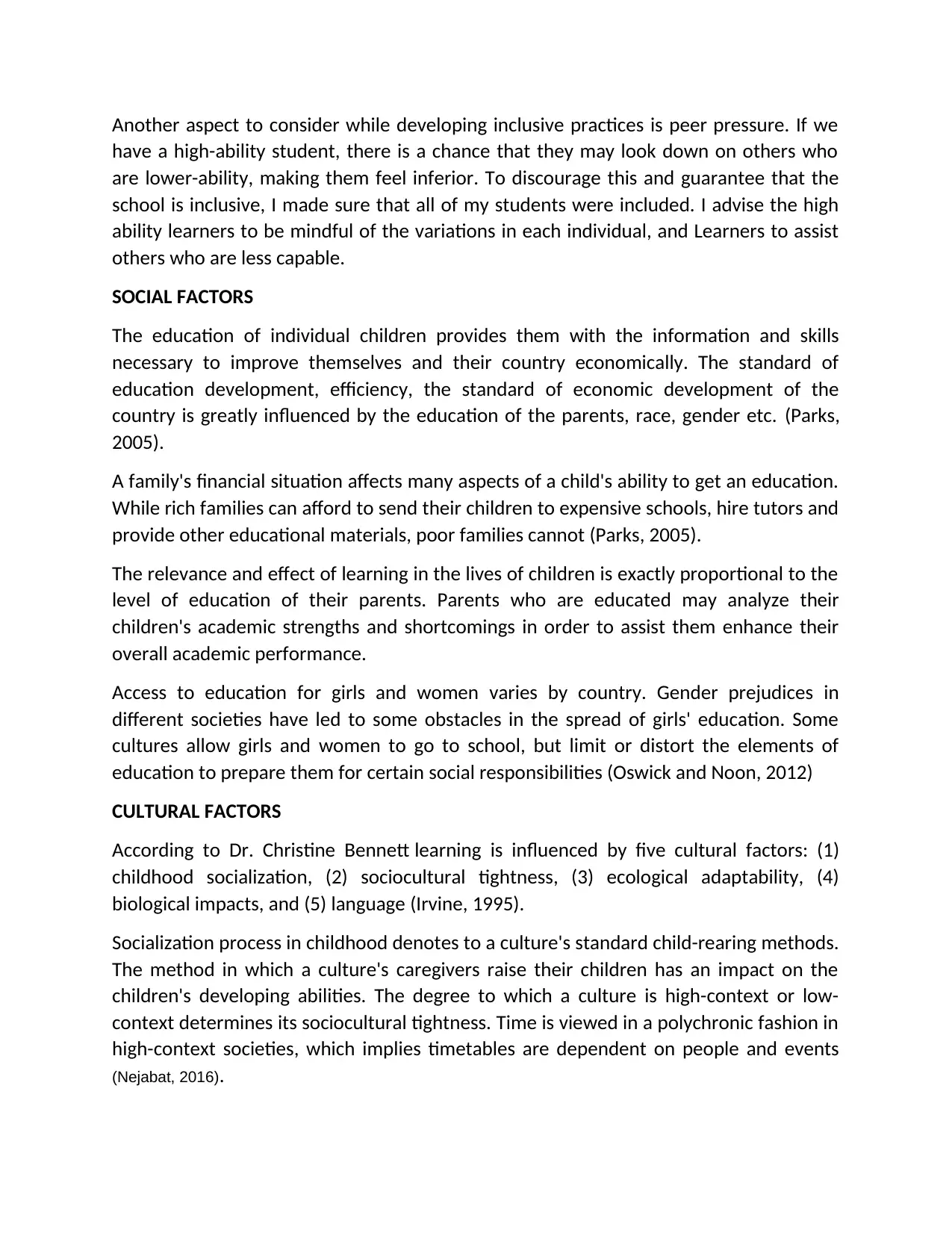
Another aspect to consider while developing inclusive practices is peer pressure. If we
have a high-ability student, there is a chance that they may look down on others who
are lower-ability, making them feel inferior. To discourage this and guarantee that the
school is inclusive, I made sure that all of my students were included. I advise the high
ability learners to be mindful of the variations in each individual, and Learners to assist
others who are less capable.
SOCIAL FACTORS
The education of individual children provides them with the information and skills
necessary to improve themselves and their country economically. The standard of
education development, efficiency, the standard of economic development of the
country is greatly influenced by the education of the parents, race, gender etc. (Parks,
2005).
A family's financial situation affects many aspects of a child's ability to get an education.
While rich families can afford to send their children to expensive schools, hire tutors and
provide other educational materials, poor families cannot (Parks, 2005).
The relevance and effect of learning in the lives of children is exactly proportional to the
level of education of their parents. Parents who are educated may analyze their
children's academic strengths and shortcomings in order to assist them enhance their
overall academic performance.
Access to education for girls and women varies by country. Gender prejudices in
different societies have led to some obstacles in the spread of girls' education. Some
cultures allow girls and women to go to school, but limit or distort the elements of
education to prepare them for certain social responsibilities (Oswick and Noon, 2012)
CULTURAL FACTORS
According to Dr. Christine Bennett learning is influenced by five cultural factors: (1)
childhood socialization, (2) sociocultural tightness, (3) ecological adaptability, (4)
biological impacts, and (5) language (Irvine, 1995).
Socialization process in childhood denotes to a culture's standard child-rearing methods.
The method in which a culture's caregivers raise their children has an impact on the
children's developing abilities. The degree to which a culture is high-context or low-
context determines its sociocultural tightness. Time is viewed in a polychronic fashion in
high-context societies, which implies timetables are dependent on people and events
(Nejabat, 2016).
have a high-ability student, there is a chance that they may look down on others who
are lower-ability, making them feel inferior. To discourage this and guarantee that the
school is inclusive, I made sure that all of my students were included. I advise the high
ability learners to be mindful of the variations in each individual, and Learners to assist
others who are less capable.
SOCIAL FACTORS
The education of individual children provides them with the information and skills
necessary to improve themselves and their country economically. The standard of
education development, efficiency, the standard of economic development of the
country is greatly influenced by the education of the parents, race, gender etc. (Parks,
2005).
A family's financial situation affects many aspects of a child's ability to get an education.
While rich families can afford to send their children to expensive schools, hire tutors and
provide other educational materials, poor families cannot (Parks, 2005).
The relevance and effect of learning in the lives of children is exactly proportional to the
level of education of their parents. Parents who are educated may analyze their
children's academic strengths and shortcomings in order to assist them enhance their
overall academic performance.
Access to education for girls and women varies by country. Gender prejudices in
different societies have led to some obstacles in the spread of girls' education. Some
cultures allow girls and women to go to school, but limit or distort the elements of
education to prepare them for certain social responsibilities (Oswick and Noon, 2012)
CULTURAL FACTORS
According to Dr. Christine Bennett learning is influenced by five cultural factors: (1)
childhood socialization, (2) sociocultural tightness, (3) ecological adaptability, (4)
biological impacts, and (5) language (Irvine, 1995).
Socialization process in childhood denotes to a culture's standard child-rearing methods.
The method in which a culture's caregivers raise their children has an impact on the
children's developing abilities. The degree to which a culture is high-context or low-
context determines its sociocultural tightness. Time is viewed in a polychronic fashion in
high-context societies, which implies timetables are dependent on people and events
(Nejabat, 2016).
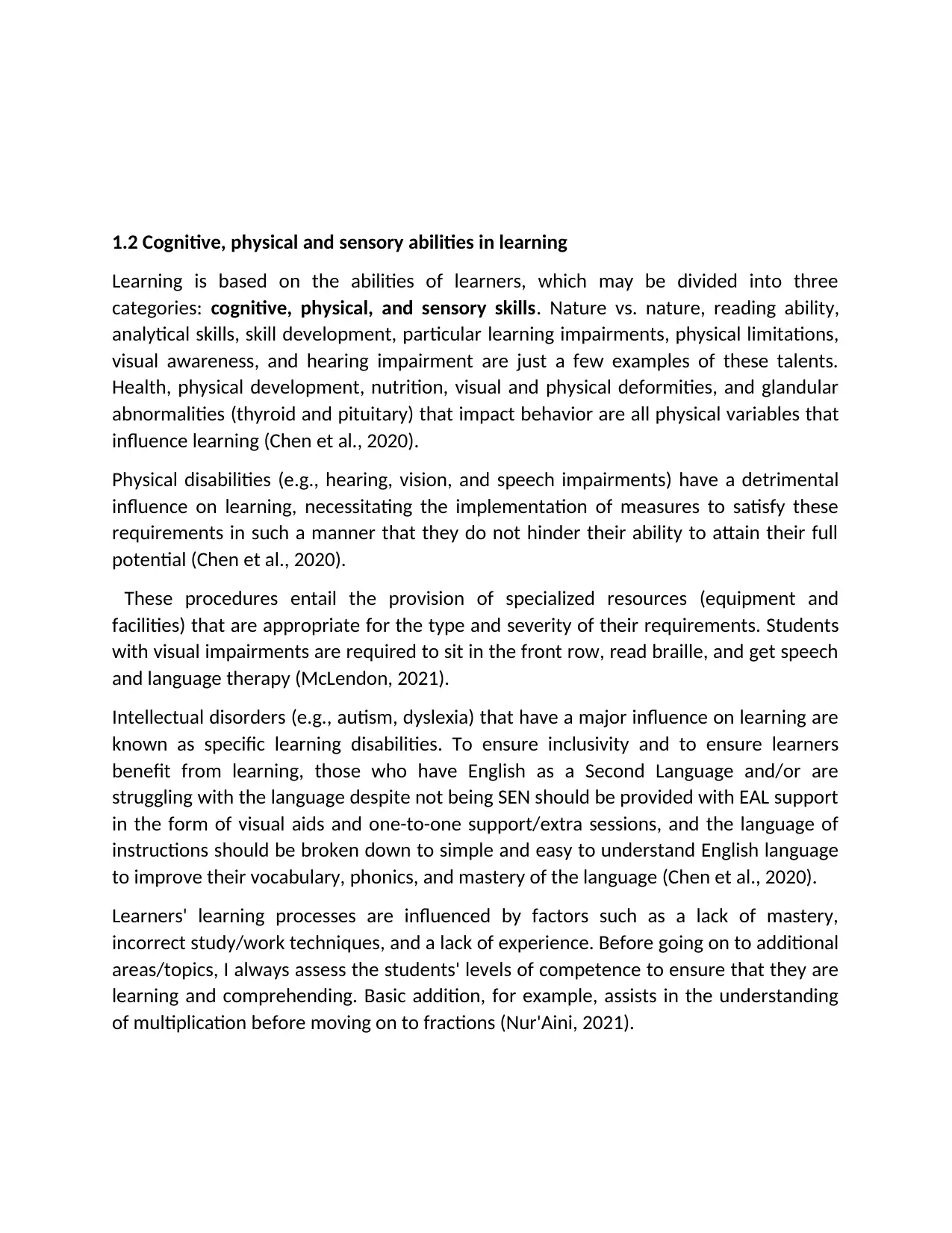
1.2 Cognitive, physical and sensory abilities in learning
Learning is based on the abilities of learners, which may be divided into three
categories: cognitive, physical, and sensory skills. Nature vs. nature, reading ability,
analytical skills, skill development, particular learning impairments, physical limitations,
visual awareness, and hearing impairment are just a few examples of these talents.
Health, physical development, nutrition, visual and physical deformities, and glandular
abnormalities (thyroid and pituitary) that impact behavior are all physical variables that
influence learning (Chen et al., 2020).
Physical disabilities (e.g., hearing, vision, and speech impairments) have a detrimental
influence on learning, necessitating the implementation of measures to satisfy these
requirements in such a manner that they do not hinder their ability to attain their full
potential (Chen et al., 2020).
These procedures entail the provision of specialized resources (equipment and
facilities) that are appropriate for the type and severity of their requirements. Students
with visual impairments are required to sit in the front row, read braille, and get speech
and language therapy (McLendon, 2021).
Intellectual disorders (e.g., autism, dyslexia) that have a major influence on learning are
known as specific learning disabilities. To ensure inclusivity and to ensure learners
benefit from learning, those who have English as a Second Language and/or are
struggling with the language despite not being SEN should be provided with EAL support
in the form of visual aids and one-to-one support/extra sessions, and the language of
instructions should be broken down to simple and easy to understand English language
to improve their vocabulary, phonics, and mastery of the language (Chen et al., 2020).
Learners' learning processes are influenced by factors such as a lack of mastery,
incorrect study/work techniques, and a lack of experience. Before going on to additional
areas/topics, I always assess the students' levels of competence to ensure that they are
learning and comprehending. Basic addition, for example, assists in the understanding
of multiplication before moving on to fractions (Nur'Aini, 2021).
Learning is based on the abilities of learners, which may be divided into three
categories: cognitive, physical, and sensory skills. Nature vs. nature, reading ability,
analytical skills, skill development, particular learning impairments, physical limitations,
visual awareness, and hearing impairment are just a few examples of these talents.
Health, physical development, nutrition, visual and physical deformities, and glandular
abnormalities (thyroid and pituitary) that impact behavior are all physical variables that
influence learning (Chen et al., 2020).
Physical disabilities (e.g., hearing, vision, and speech impairments) have a detrimental
influence on learning, necessitating the implementation of measures to satisfy these
requirements in such a manner that they do not hinder their ability to attain their full
potential (Chen et al., 2020).
These procedures entail the provision of specialized resources (equipment and
facilities) that are appropriate for the type and severity of their requirements. Students
with visual impairments are required to sit in the front row, read braille, and get speech
and language therapy (McLendon, 2021).
Intellectual disorders (e.g., autism, dyslexia) that have a major influence on learning are
known as specific learning disabilities. To ensure inclusivity and to ensure learners
benefit from learning, those who have English as a Second Language and/or are
struggling with the language despite not being SEN should be provided with EAL support
in the form of visual aids and one-to-one support/extra sessions, and the language of
instructions should be broken down to simple and easy to understand English language
to improve their vocabulary, phonics, and mastery of the language (Chen et al., 2020).
Learners' learning processes are influenced by factors such as a lack of mastery,
incorrect study/work techniques, and a lack of experience. Before going on to additional
areas/topics, I always assess the students' levels of competence to ensure that they are
learning and comprehending. Basic addition, for example, assists in the understanding
of multiplication before moving on to fractions (Nur'Aini, 2021).
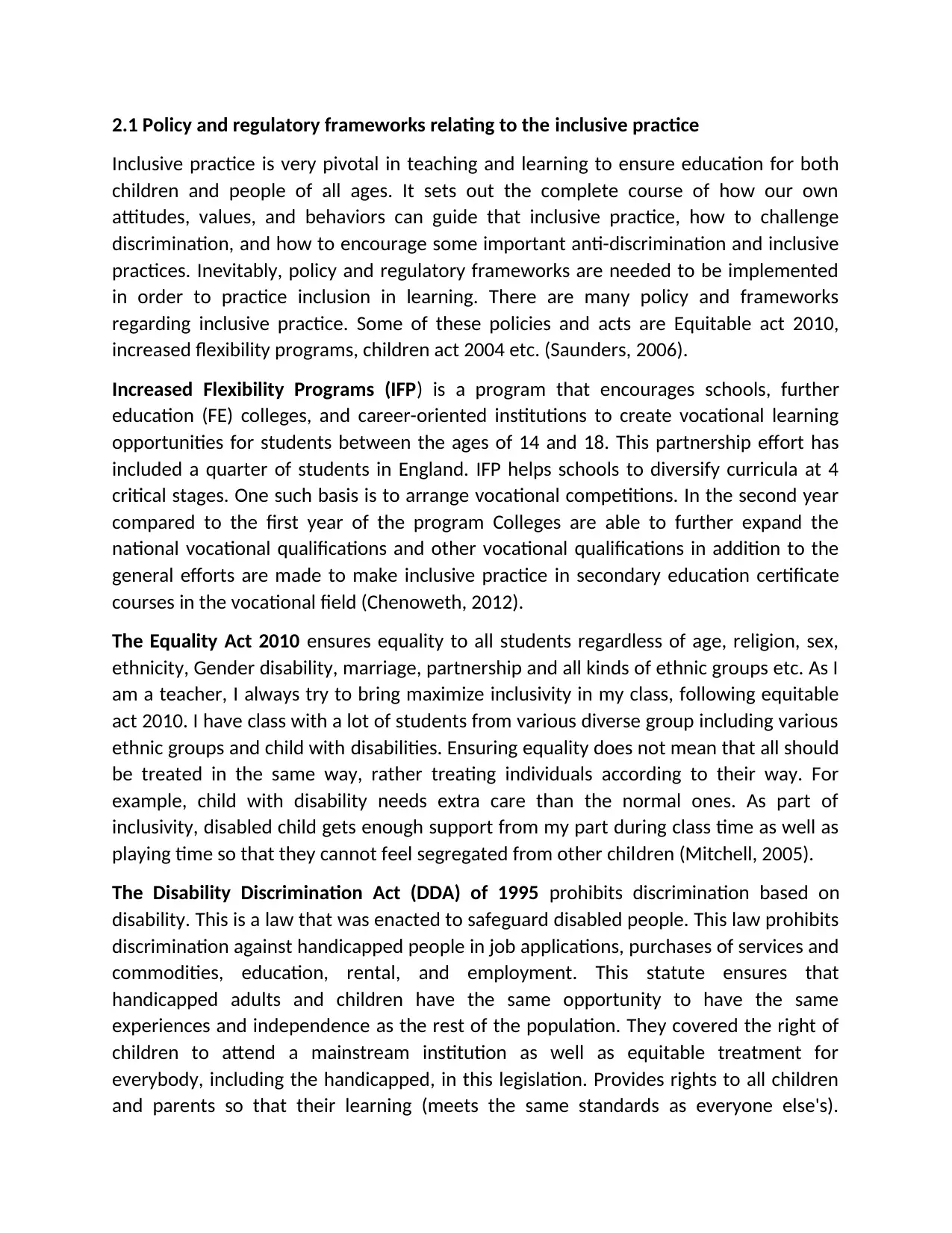
2.1 Policy and regulatory frameworks relating to the inclusive practice
Inclusive practice is very pivotal in teaching and learning to ensure education for both
children and people of all ages. It sets out the complete course of how our own
attitudes, values, and behaviors can guide that inclusive practice, how to challenge
discrimination, and how to encourage some important anti-discrimination and inclusive
practices. Inevitably, policy and regulatory frameworks are needed to be implemented
in order to practice inclusion in learning. There are many policy and frameworks
regarding inclusive practice. Some of these policies and acts are Equitable act 2010,
increased flexibility programs, children act 2004 etc. (Saunders, 2006).
Increased Flexibility Programs (IFP) is a program that encourages schools, further
education (FE) colleges, and career-oriented institutions to create vocational learning
opportunities for students between the ages of 14 and 18. This partnership effort has
included a quarter of students in England. IFP helps schools to diversify curricula at 4
critical stages. One such basis is to arrange vocational competitions. In the second year
compared to the first year of the program Colleges are able to further expand the
national vocational qualifications and other vocational qualifications in addition to the
general efforts are made to make inclusive practice in secondary education certificate
courses in the vocational field (Chenoweth, 2012).
The Equality Act 2010 ensures equality to all students regardless of age, religion, sex,
ethnicity, Gender disability, marriage, partnership and all kinds of ethnic groups etc. As I
am a teacher, I always try to bring maximize inclusivity in my class, following equitable
act 2010. I have class with a lot of students from various diverse group including various
ethnic groups and child with disabilities. Ensuring equality does not mean that all should
be treated in the same way, rather treating individuals according to their way. For
example, child with disability needs extra care than the normal ones. As part of
inclusivity, disabled child gets enough support from my part during class time as well as
playing time so that they cannot feel segregated from other children (Mitchell, 2005).
The Disability Discrimination Act (DDA) of 1995 prohibits discrimination based on
disability. This is a law that was enacted to safeguard disabled people. This law prohibits
discrimination against handicapped people in job applications, purchases of services and
commodities, education, rental, and employment. This statute ensures that
handicapped adults and children have the same opportunity to have the same
experiences and independence as the rest of the population. They covered the right of
children to attend a mainstream institution as well as equitable treatment for
everybody, including the handicapped, in this legislation. Provides rights to all children
and parents so that their learning (meets the same standards as everyone else's).
Inclusive practice is very pivotal in teaching and learning to ensure education for both
children and people of all ages. It sets out the complete course of how our own
attitudes, values, and behaviors can guide that inclusive practice, how to challenge
discrimination, and how to encourage some important anti-discrimination and inclusive
practices. Inevitably, policy and regulatory frameworks are needed to be implemented
in order to practice inclusion in learning. There are many policy and frameworks
regarding inclusive practice. Some of these policies and acts are Equitable act 2010,
increased flexibility programs, children act 2004 etc. (Saunders, 2006).
Increased Flexibility Programs (IFP) is a program that encourages schools, further
education (FE) colleges, and career-oriented institutions to create vocational learning
opportunities for students between the ages of 14 and 18. This partnership effort has
included a quarter of students in England. IFP helps schools to diversify curricula at 4
critical stages. One such basis is to arrange vocational competitions. In the second year
compared to the first year of the program Colleges are able to further expand the
national vocational qualifications and other vocational qualifications in addition to the
general efforts are made to make inclusive practice in secondary education certificate
courses in the vocational field (Chenoweth, 2012).
The Equality Act 2010 ensures equality to all students regardless of age, religion, sex,
ethnicity, Gender disability, marriage, partnership and all kinds of ethnic groups etc. As I
am a teacher, I always try to bring maximize inclusivity in my class, following equitable
act 2010. I have class with a lot of students from various diverse group including various
ethnic groups and child with disabilities. Ensuring equality does not mean that all should
be treated in the same way, rather treating individuals according to their way. For
example, child with disability needs extra care than the normal ones. As part of
inclusivity, disabled child gets enough support from my part during class time as well as
playing time so that they cannot feel segregated from other children (Mitchell, 2005).
The Disability Discrimination Act (DDA) of 1995 prohibits discrimination based on
disability. This is a law that was enacted to safeguard disabled people. This law prohibits
discrimination against handicapped people in job applications, purchases of services and
commodities, education, rental, and employment. This statute ensures that
handicapped adults and children have the same opportunity to have the same
experiences and independence as the rest of the population. They covered the right of
children to attend a mainstream institution as well as equitable treatment for
everybody, including the handicapped, in this legislation. Provides rights to all children
and parents so that their learning (meets the same standards as everyone else's).
Secure Best Marks with AI Grader
Need help grading? Try our AI Grader for instant feedback on your assignments.
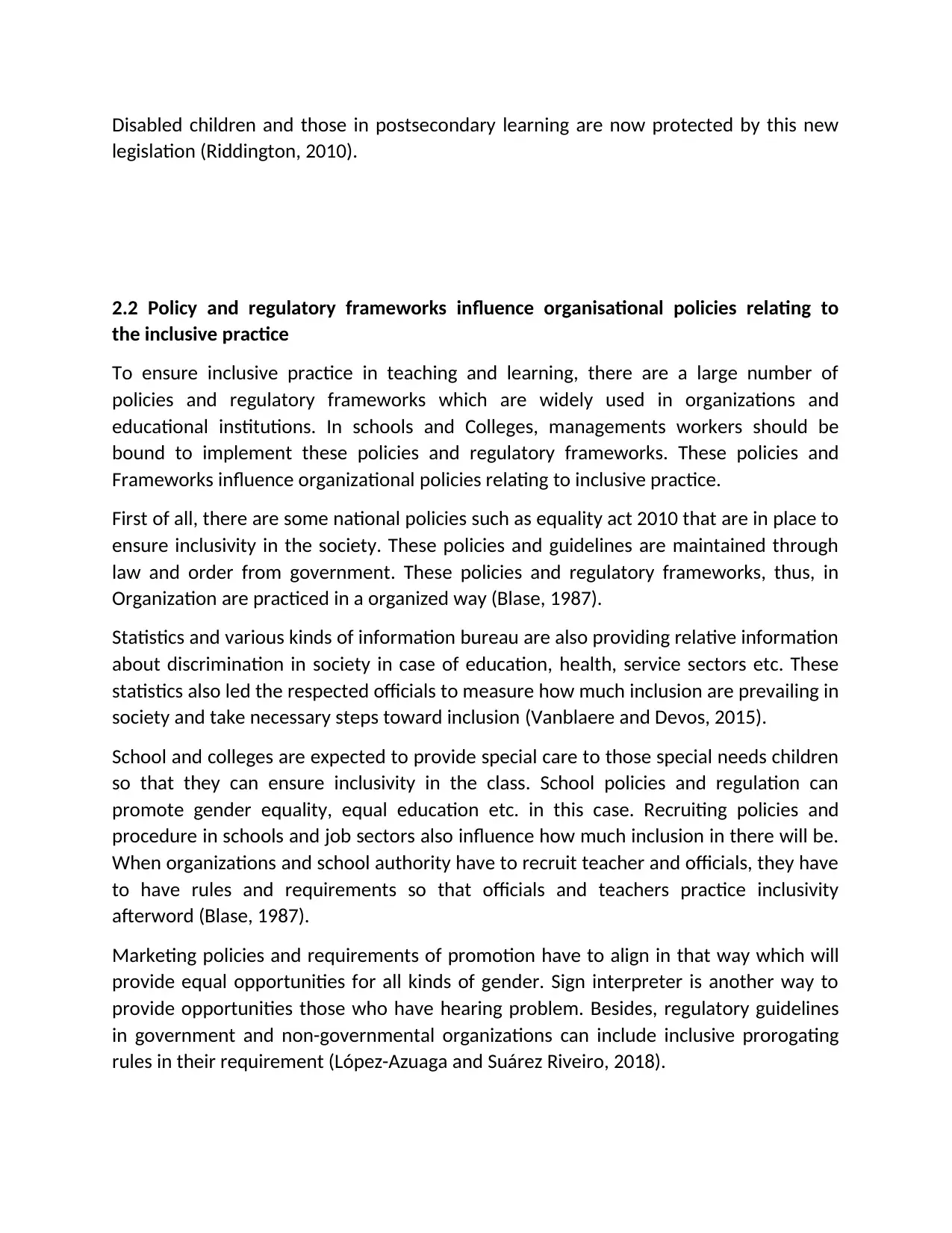
Disabled children and those in postsecondary learning are now protected by this new
legislation (Riddington, 2010).
2.2 Policy and regulatory frameworks influence organisational policies relating to
the inclusive practice
To ensure inclusive practice in teaching and learning, there are a large number of
policies and regulatory frameworks which are widely used in organizations and
educational institutions. In schools and Colleges, managements workers should be
bound to implement these policies and regulatory frameworks. These policies and
Frameworks influence organizational policies relating to inclusive practice.
First of all, there are some national policies such as equality act 2010 that are in place to
ensure inclusivity in the society. These policies and guidelines are maintained through
law and order from government. These policies and regulatory frameworks, thus, in
Organization are practiced in a organized way (Blase, 1987).
Statistics and various kinds of information bureau are also providing relative information
about discrimination in society in case of education, health, service sectors etc. These
statistics also led the respected officials to measure how much inclusion are prevailing in
society and take necessary steps toward inclusion (Vanblaere and Devos, 2015).
School and colleges are expected to provide special care to those special needs children
so that they can ensure inclusivity in the class. School policies and regulation can
promote gender equality, equal education etc. in this case. Recruiting policies and
procedure in schools and job sectors also influence how much inclusion in there will be.
When organizations and school authority have to recruit teacher and officials, they have
to have rules and requirements so that officials and teachers practice inclusivity
afterword (Blase, 1987).
Marketing policies and requirements of promotion have to align in that way which will
provide equal opportunities for all kinds of gender. Sign interpreter is another way to
provide opportunities those who have hearing problem. Besides, regulatory guidelines
in government and non-governmental organizations can include inclusive prorogating
rules in their requirement (López-Azuaga and Suárez Riveiro, 2018).
legislation (Riddington, 2010).
2.2 Policy and regulatory frameworks influence organisational policies relating to
the inclusive practice
To ensure inclusive practice in teaching and learning, there are a large number of
policies and regulatory frameworks which are widely used in organizations and
educational institutions. In schools and Colleges, managements workers should be
bound to implement these policies and regulatory frameworks. These policies and
Frameworks influence organizational policies relating to inclusive practice.
First of all, there are some national policies such as equality act 2010 that are in place to
ensure inclusivity in the society. These policies and guidelines are maintained through
law and order from government. These policies and regulatory frameworks, thus, in
Organization are practiced in a organized way (Blase, 1987).
Statistics and various kinds of information bureau are also providing relative information
about discrimination in society in case of education, health, service sectors etc. These
statistics also led the respected officials to measure how much inclusion are prevailing in
society and take necessary steps toward inclusion (Vanblaere and Devos, 2015).
School and colleges are expected to provide special care to those special needs children
so that they can ensure inclusivity in the class. School policies and regulation can
promote gender equality, equal education etc. in this case. Recruiting policies and
procedure in schools and job sectors also influence how much inclusion in there will be.
When organizations and school authority have to recruit teacher and officials, they have
to have rules and requirements so that officials and teachers practice inclusivity
afterword (Blase, 1987).
Marketing policies and requirements of promotion have to align in that way which will
provide equal opportunities for all kinds of gender. Sign interpreter is another way to
provide opportunities those who have hearing problem. Besides, regulatory guidelines
in government and non-governmental organizations can include inclusive prorogating
rules in their requirement (López-Azuaga and Suárez Riveiro, 2018).

2.3 Policy and regulatory frameworks influence own inclusive practice
Regulatory and policy frameworks are the main shields to ensure inclusivity in
organizations and institutions. These policy and framework keep individuals in the
inclusive practice in their workplace. These rules and regulations also make individual
responsible for their breaching of inclusivity in their regular work. So, I always try not to
breach any law regarding inclusivity and make sure to practice existing policies in my
organizations through proper guidelines.
I always attempt to bring the courage to ensure that students of both gender are
precipitating in my class and students with various limitations are getting equal
opportunities as their performance depend on the inclusive practice of the class.
Regulatory frameworks in that case helps me to abide the inclusion practice. Besides, I
always motivate my students to treat others fairly and equally both in the class and in
everyday life (Lancer, 2014).
School charters and regulatory frameworks in terms of inclusive practice include various
programs such as training program, recruiting rules, behavioral norms, introduction of
various helping technology for disabled students etc. Regular observation and data
collection also help me to measure the improvement. Under these policies I can make
the inclusive practice compulsory that in response make my inclusive practice effective
(Hardin and Hardin, 2002).
There may be a group of kids in a classroom who are rapid learners or experts in a
certain area; these pupils are known as smart and outstanding. If there isn't enough
challenging material for them to accomplish, the teacher should not leave students
alone to work. The quality of a school is decided by its students' performance, and
without inclusive policies, there would be a huge gap between the competent and less
capable students, resulting in poor quality assurance for the institution (Lancer, 2014).
3.1. My Own role and responsibilities relating to the inclusive practice
As a College lecturer, I have my own role and responsibility relation to inclusion, equity
and equality in learning. There are diverse group of students, teachers, stakeholders
with which I have to coordinate rules and regulations of inclusive practice. That inclusive
practice coordinating various kinds of individuals will be ensured in the College setting is
expected from me as a mentor as well as a coordinator. To implement a culture of
inclusion in my college setting, I have to follow some way out there as following-
Planning, evaluating and implementing or delivering lessons pertaining to the inclusion
are one of the main task of a College lecturer who have the passion to value all of his
Regulatory and policy frameworks are the main shields to ensure inclusivity in
organizations and institutions. These policy and framework keep individuals in the
inclusive practice in their workplace. These rules and regulations also make individual
responsible for their breaching of inclusivity in their regular work. So, I always try not to
breach any law regarding inclusivity and make sure to practice existing policies in my
organizations through proper guidelines.
I always attempt to bring the courage to ensure that students of both gender are
precipitating in my class and students with various limitations are getting equal
opportunities as their performance depend on the inclusive practice of the class.
Regulatory frameworks in that case helps me to abide the inclusion practice. Besides, I
always motivate my students to treat others fairly and equally both in the class and in
everyday life (Lancer, 2014).
School charters and regulatory frameworks in terms of inclusive practice include various
programs such as training program, recruiting rules, behavioral norms, introduction of
various helping technology for disabled students etc. Regular observation and data
collection also help me to measure the improvement. Under these policies I can make
the inclusive practice compulsory that in response make my inclusive practice effective
(Hardin and Hardin, 2002).
There may be a group of kids in a classroom who are rapid learners or experts in a
certain area; these pupils are known as smart and outstanding. If there isn't enough
challenging material for them to accomplish, the teacher should not leave students
alone to work. The quality of a school is decided by its students' performance, and
without inclusive policies, there would be a huge gap between the competent and less
capable students, resulting in poor quality assurance for the institution (Lancer, 2014).
3.1. My Own role and responsibilities relating to the inclusive practice
As a College lecturer, I have my own role and responsibility relation to inclusion, equity
and equality in learning. There are diverse group of students, teachers, stakeholders
with which I have to coordinate rules and regulations of inclusive practice. That inclusive
practice coordinating various kinds of individuals will be ensured in the College setting is
expected from me as a mentor as well as a coordinator. To implement a culture of
inclusion in my college setting, I have to follow some way out there as following-
Planning, evaluating and implementing or delivering lessons pertaining to the inclusion
are one of the main task of a College lecturer who have the passion to value all of his

students equally. First of all, I have to understand the current culture the College
environment is fostering, and then do what I need accordingly. To measure inclusion in
current situation, I need to collect data and thoughts of teachers and students about
inclusivity (Naraian and Amrhein, 2020).
Then, I have the responsibility to raise awareness to all about the benefits of inclusive
practice in teaching and learning. In this case, gathered data will help me understand
how many students with special need are included in mainstream learning, and those
who are included in mainstreaming learning whether are performing in pace with other
learners or getting the supports they need in learning.
I can increase the practice of teamwork to enhance equity minded spirits among the
learners. I will set principles and behavioral terms that will introduce them to practice
inclusivity. Goal of bringing every student in learning equally is quite difficult as all
students have not equal quality to digest learning. I need to develop an agenda that will
be a set to principles and policies required to implement practices of inclusivity in
school. Monthly evaluation and meeting can be arranged to line up students and
teachers on inclusion.
Training facilities and opportunity to Professional development should be given all
stakeholders of Organization, as teachers and learner may to be acquainted with
inclusive practice properly. Without proper skills and training Program, a teacher will
not be able to practice inclusivity in the right way (Naraian and Amrhein, 2020).
Finally, I can observe the regular progress of my colleagues and students about inclusive
practice in the school culture. If needed, regular meetings with them can be arranged.
Students should be under complete observation to see whether they are working
collaboratively with mentors and getting supports equally.
3.2 Relationship between own role and the roles of other professionals involved in the
inclusive practice.
A mentor’s connection with the professionals who aid in increasing the efficacy of
inclusive learning practices needs to be courteous, and ability of should be understood.
This is due to the fact that intimate connections that take other people's limitations into
consideration to continue this programme longer. Trespassing into another person's
activities, in contrast, may lead to arguments since capacity of everyone is not the, and
not everyone will take things easily. Some individuals may get this offensive when their
individual boundaries are limited (Zhao, 2013) .
environment is fostering, and then do what I need accordingly. To measure inclusion in
current situation, I need to collect data and thoughts of teachers and students about
inclusivity (Naraian and Amrhein, 2020).
Then, I have the responsibility to raise awareness to all about the benefits of inclusive
practice in teaching and learning. In this case, gathered data will help me understand
how many students with special need are included in mainstream learning, and those
who are included in mainstreaming learning whether are performing in pace with other
learners or getting the supports they need in learning.
I can increase the practice of teamwork to enhance equity minded spirits among the
learners. I will set principles and behavioral terms that will introduce them to practice
inclusivity. Goal of bringing every student in learning equally is quite difficult as all
students have not equal quality to digest learning. I need to develop an agenda that will
be a set to principles and policies required to implement practices of inclusivity in
school. Monthly evaluation and meeting can be arranged to line up students and
teachers on inclusion.
Training facilities and opportunity to Professional development should be given all
stakeholders of Organization, as teachers and learner may to be acquainted with
inclusive practice properly. Without proper skills and training Program, a teacher will
not be able to practice inclusivity in the right way (Naraian and Amrhein, 2020).
Finally, I can observe the regular progress of my colleagues and students about inclusive
practice in the school culture. If needed, regular meetings with them can be arranged.
Students should be under complete observation to see whether they are working
collaboratively with mentors and getting supports equally.
3.2 Relationship between own role and the roles of other professionals involved in the
inclusive practice.
A mentor’s connection with the professionals who aid in increasing the efficacy of
inclusive learning practices needs to be courteous, and ability of should be understood.
This is due to the fact that intimate connections that take other people's limitations into
consideration to continue this programme longer. Trespassing into another person's
activities, in contrast, may lead to arguments since capacity of everyone is not the, and
not everyone will take things easily. Some individuals may get this offensive when their
individual boundaries are limited (Zhao, 2013) .
Paraphrase This Document
Need a fresh take? Get an instant paraphrase of this document with our AI Paraphraser

The main and primary purpose of the professional-teacher connection is to assist
students in learning in a pleasant and easy-to-understand environment with rich
experience. The majority of these experts might be from organizations where many of
their employees are parents of students enrolled in that school, and they are driven to
ensure that their children study diligently so that they can have a happy life in the
future. Some of these experts may be instructors from other colleges who would benefit
from benchmarking with colleagues from another school (Mortier, 2018).
The relationship between me as a teacher and other professional in terms of inclusive
practice is that both are tasked with the responsibility of bringing all in workplace
together with equal share and opportunities. Both I and other professionals practicing
inclusivity in their workplace have to liaise with authorities and institutions to manage
proper training opportunity for students and stakeholders. We work as a link to ensure
that.
I arrange programs to provide students to become facilitated with training for inclusive
practice. I bring guests and many other professionals in these seminar and symposium
to share their experience of inclusion in their workplace and describe the needs to learn
bringing together. They advocate and motivate the students to ensure inclusive
behavior both in their educational institutes and everyday life.
I also observe whether the students are being affected by any type of dogmatic
characteristic that reduce inclusivity in their class. Regular data collecting and assigning
my colleagues to report me regular on that basis do not only make the inclusion
sustainable but also durable. Professionals do the same in their case, as inclusive
practice require main objective of bringing together while other components vary in
different environments (Hawkes, 1994).
3.3 Points of referral available to meet individual learning needs
students can learn effective inclusive learning through various points of referral which
can be ranged from Organization to various policies and regulations Advocating for
inclusivity in learning. Legislation on inclusivity is one of the good referrals for students
to help them understand the guidance regarding inclusive practice in the general social
arena. Legislative acts such as The Equity Act 2010 directs some do and don't that are
permitted and prohibited by the law while practicing inclusive learning. In this way,
leaners become able to know the present curricula of existing policies, and know
students in learning in a pleasant and easy-to-understand environment with rich
experience. The majority of these experts might be from organizations where many of
their employees are parents of students enrolled in that school, and they are driven to
ensure that their children study diligently so that they can have a happy life in the
future. Some of these experts may be instructors from other colleges who would benefit
from benchmarking with colleagues from another school (Mortier, 2018).
The relationship between me as a teacher and other professional in terms of inclusive
practice is that both are tasked with the responsibility of bringing all in workplace
together with equal share and opportunities. Both I and other professionals practicing
inclusivity in their workplace have to liaise with authorities and institutions to manage
proper training opportunity for students and stakeholders. We work as a link to ensure
that.
I arrange programs to provide students to become facilitated with training for inclusive
practice. I bring guests and many other professionals in these seminar and symposium
to share their experience of inclusion in their workplace and describe the needs to learn
bringing together. They advocate and motivate the students to ensure inclusive
behavior both in their educational institutes and everyday life.
I also observe whether the students are being affected by any type of dogmatic
characteristic that reduce inclusivity in their class. Regular data collecting and assigning
my colleagues to report me regular on that basis do not only make the inclusion
sustainable but also durable. Professionals do the same in their case, as inclusive
practice require main objective of bringing together while other components vary in
different environments (Hawkes, 1994).
3.3 Points of referral available to meet individual learning needs
students can learn effective inclusive learning through various points of referral which
can be ranged from Organization to various policies and regulations Advocating for
inclusivity in learning. Legislation on inclusivity is one of the good referrals for students
to help them understand the guidance regarding inclusive practice in the general social
arena. Legislative acts such as The Equity Act 2010 directs some do and don't that are
permitted and prohibited by the law while practicing inclusive learning. In this way,
leaners become able to know the present curricula of existing policies, and know
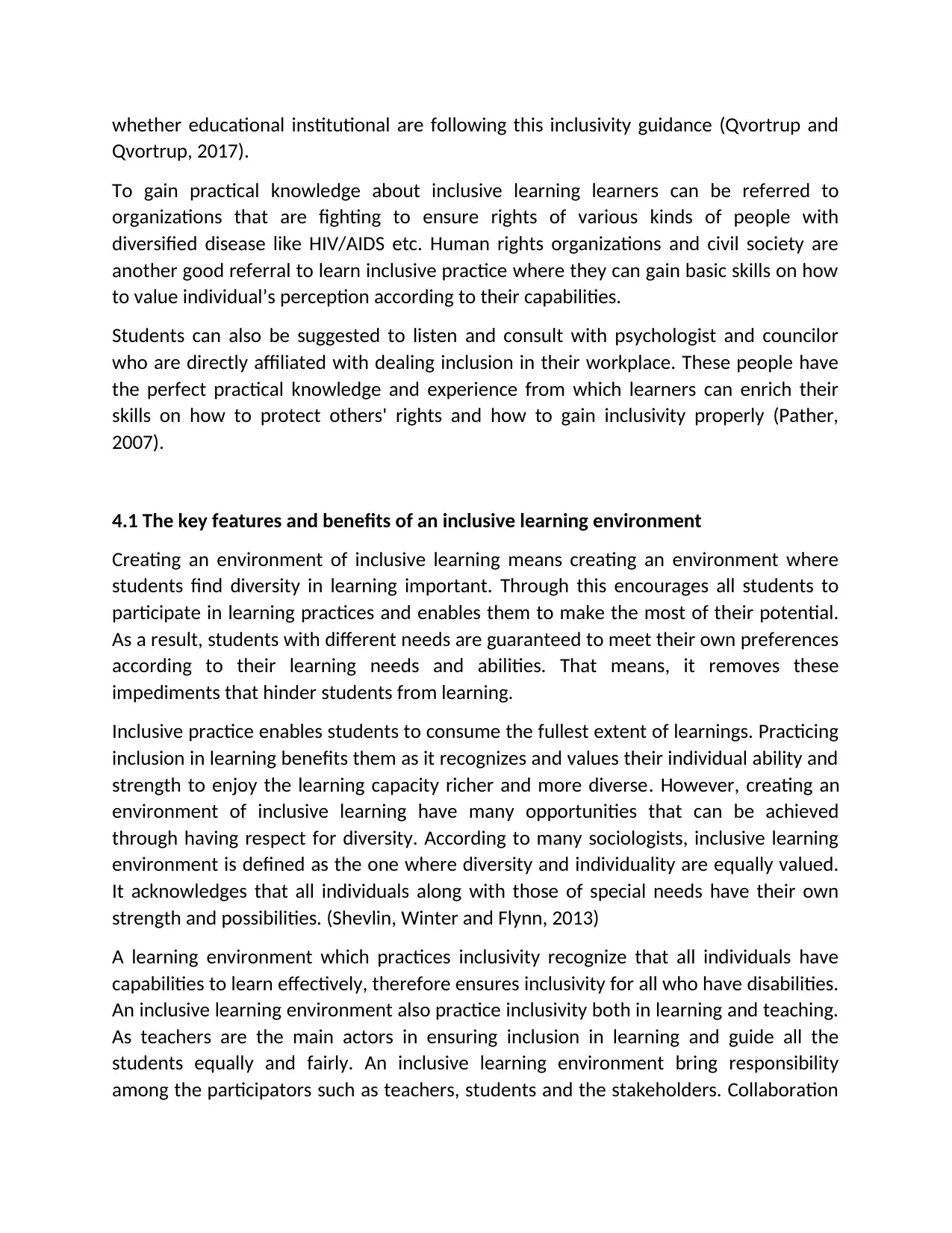
whether educational institutional are following this inclusivity guidance (Qvortrup and
Qvortrup, 2017).
To gain practical knowledge about inclusive learning learners can be referred to
organizations that are fighting to ensure rights of various kinds of people with
diversified disease like HIV/AIDS etc. Human rights organizations and civil society are
another good referral to learn inclusive practice where they can gain basic skills on how
to value individual’s perception according to their capabilities.
Students can also be suggested to listen and consult with psychologist and councilor
who are directly affiliated with dealing inclusion in their workplace. These people have
the perfect practical knowledge and experience from which learners can enrich their
skills on how to protect others' rights and how to gain inclusivity properly (Pather,
2007).
4.1 The key features and benefits of an inclusive learning environment
Creating an environment of inclusive learning means creating an environment where
students find diversity in learning important. Through this encourages all students to
participate in learning practices and enables them to make the most of their potential.
As a result, students with different needs are guaranteed to meet their own preferences
according to their learning needs and abilities. That means, it removes these
impediments that hinder students from learning.
Inclusive practice enables students to consume the fullest extent of learnings. Practicing
inclusion in learning benefits them as it recognizes and values their individual ability and
strength to enjoy the learning capacity richer and more diverse. However, creating an
environment of inclusive learning have many opportunities that can be achieved
through having respect for diversity. According to many sociologists, inclusive learning
environment is defined as the one where diversity and individuality are equally valued.
It acknowledges that all individuals along with those of special needs have their own
strength and possibilities. (Shevlin, Winter and Flynn, 2013)
A learning environment which practices inclusivity recognize that all individuals have
capabilities to learn effectively, therefore ensures inclusivity for all who have disabilities.
An inclusive learning environment also practice inclusivity both in learning and teaching.
As teachers are the main actors in ensuring inclusion in learning and guide all the
students equally and fairly. An inclusive learning environment bring responsibility
among the participators such as teachers, students and the stakeholders. Collaboration
Qvortrup, 2017).
To gain practical knowledge about inclusive learning learners can be referred to
organizations that are fighting to ensure rights of various kinds of people with
diversified disease like HIV/AIDS etc. Human rights organizations and civil society are
another good referral to learn inclusive practice where they can gain basic skills on how
to value individual’s perception according to their capabilities.
Students can also be suggested to listen and consult with psychologist and councilor
who are directly affiliated with dealing inclusion in their workplace. These people have
the perfect practical knowledge and experience from which learners can enrich their
skills on how to protect others' rights and how to gain inclusivity properly (Pather,
2007).
4.1 The key features and benefits of an inclusive learning environment
Creating an environment of inclusive learning means creating an environment where
students find diversity in learning important. Through this encourages all students to
participate in learning practices and enables them to make the most of their potential.
As a result, students with different needs are guaranteed to meet their own preferences
according to their learning needs and abilities. That means, it removes these
impediments that hinder students from learning.
Inclusive practice enables students to consume the fullest extent of learnings. Practicing
inclusion in learning benefits them as it recognizes and values their individual ability and
strength to enjoy the learning capacity richer and more diverse. However, creating an
environment of inclusive learning have many opportunities that can be achieved
through having respect for diversity. According to many sociologists, inclusive learning
environment is defined as the one where diversity and individuality are equally valued.
It acknowledges that all individuals along with those of special needs have their own
strength and possibilities. (Shevlin, Winter and Flynn, 2013)
A learning environment which practices inclusivity recognize that all individuals have
capabilities to learn effectively, therefore ensures inclusivity for all who have disabilities.
An inclusive learning environment also practice inclusivity both in learning and teaching.
As teachers are the main actors in ensuring inclusion in learning and guide all the
students equally and fairly. An inclusive learning environment bring responsibility
among the participators such as teachers, students and the stakeholders. Collaboration
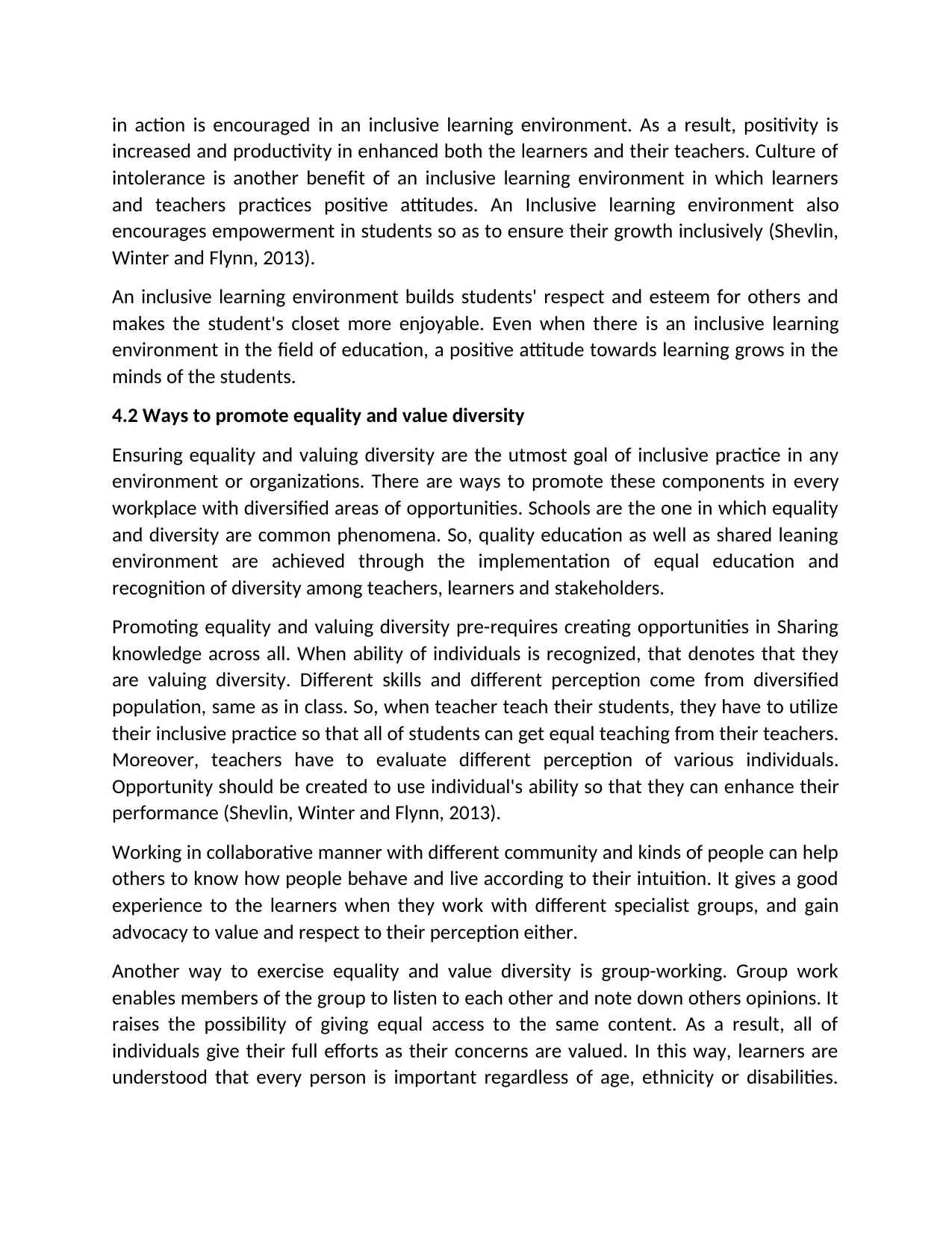
in action is encouraged in an inclusive learning environment. As a result, positivity is
increased and productivity in enhanced both the learners and their teachers. Culture of
intolerance is another benefit of an inclusive learning environment in which learners
and teachers practices positive attitudes. An Inclusive learning environment also
encourages empowerment in students so as to ensure their growth inclusively (Shevlin,
Winter and Flynn, 2013).
An inclusive learning environment builds students' respect and esteem for others and
makes the student's closet more enjoyable. Even when there is an inclusive learning
environment in the field of education, a positive attitude towards learning grows in the
minds of the students.
4.2 Ways to promote equality and value diversity
Ensuring equality and valuing diversity are the utmost goal of inclusive practice in any
environment or organizations. There are ways to promote these components in every
workplace with diversified areas of opportunities. Schools are the one in which equality
and diversity are common phenomena. So, quality education as well as shared leaning
environment are achieved through the implementation of equal education and
recognition of diversity among teachers, learners and stakeholders.
Promoting equality and valuing diversity pre-requires creating opportunities in Sharing
knowledge across all. When ability of individuals is recognized, that denotes that they
are valuing diversity. Different skills and different perception come from diversified
population, same as in class. So, when teacher teach their students, they have to utilize
their inclusive practice so that all of students can get equal teaching from their teachers.
Moreover, teachers have to evaluate different perception of various individuals.
Opportunity should be created to use individual's ability so that they can enhance their
performance (Shevlin, Winter and Flynn, 2013).
Working in collaborative manner with different community and kinds of people can help
others to know how people behave and live according to their intuition. It gives a good
experience to the learners when they work with different specialist groups, and gain
advocacy to value and respect to their perception either.
Another way to exercise equality and value diversity is group-working. Group work
enables members of the group to listen to each other and note down others opinions. It
raises the possibility of giving equal access to the same content. As a result, all of
individuals give their full efforts as their concerns are valued. In this way, learners are
understood that every person is important regardless of age, ethnicity or disabilities.
increased and productivity in enhanced both the learners and their teachers. Culture of
intolerance is another benefit of an inclusive learning environment in which learners
and teachers practices positive attitudes. An Inclusive learning environment also
encourages empowerment in students so as to ensure their growth inclusively (Shevlin,
Winter and Flynn, 2013).
An inclusive learning environment builds students' respect and esteem for others and
makes the student's closet more enjoyable. Even when there is an inclusive learning
environment in the field of education, a positive attitude towards learning grows in the
minds of the students.
4.2 Ways to promote equality and value diversity
Ensuring equality and valuing diversity are the utmost goal of inclusive practice in any
environment or organizations. There are ways to promote these components in every
workplace with diversified areas of opportunities. Schools are the one in which equality
and diversity are common phenomena. So, quality education as well as shared leaning
environment are achieved through the implementation of equal education and
recognition of diversity among teachers, learners and stakeholders.
Promoting equality and valuing diversity pre-requires creating opportunities in Sharing
knowledge across all. When ability of individuals is recognized, that denotes that they
are valuing diversity. Different skills and different perception come from diversified
population, same as in class. So, when teacher teach their students, they have to utilize
their inclusive practice so that all of students can get equal teaching from their teachers.
Moreover, teachers have to evaluate different perception of various individuals.
Opportunity should be created to use individual's ability so that they can enhance their
performance (Shevlin, Winter and Flynn, 2013).
Working in collaborative manner with different community and kinds of people can help
others to know how people behave and live according to their intuition. It gives a good
experience to the learners when they work with different specialist groups, and gain
advocacy to value and respect to their perception either.
Another way to exercise equality and value diversity is group-working. Group work
enables members of the group to listen to each other and note down others opinions. It
raises the possibility of giving equal access to the same content. As a result, all of
individuals give their full efforts as their concerns are valued. In this way, learners are
understood that every person is important regardless of age, ethnicity or disabilities.
Secure Best Marks with AI Grader
Need help grading? Try our AI Grader for instant feedback on your assignments.
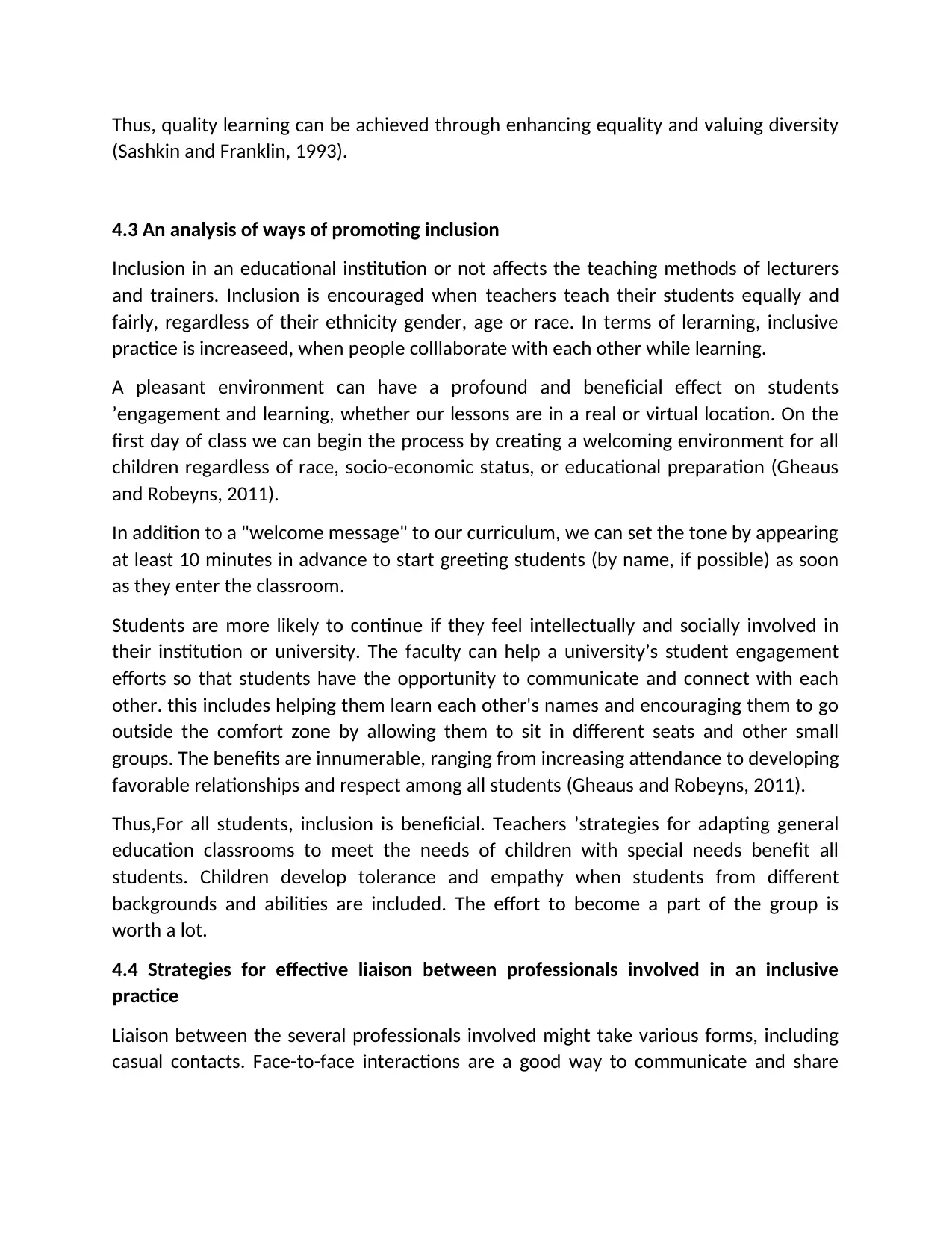
Thus, quality learning can be achieved through enhancing equality and valuing diversity
(Sashkin and Franklin, 1993).
4.3 An analysis of ways of promoting inclusion
Inclusion in an educational institution or not affects the teaching methods of lecturers
and trainers. Inclusion is encouraged when teachers teach their students equally and
fairly, regardless of their ethnicity gender, age or race. In terms of lerarning, inclusive
practice is increaseed, when people colllaborate with each other while learning.
A pleasant environment can have a profound and beneficial effect on students
’engagement and learning, whether our lessons are in a real or virtual location. On the
first day of class we can begin the process by creating a welcoming environment for all
children regardless of race, socio-economic status, or educational preparation (Gheaus
and Robeyns, 2011).
In addition to a "welcome message" to our curriculum, we can set the tone by appearing
at least 10 minutes in advance to start greeting students (by name, if possible) as soon
as they enter the classroom.
Students are more likely to continue if they feel intellectually and socially involved in
their institution or university. The faculty can help a university’s student engagement
efforts so that students have the opportunity to communicate and connect with each
other. this includes helping them learn each other's names and encouraging them to go
outside the comfort zone by allowing them to sit in different seats and other small
groups. The benefits are innumerable, ranging from increasing attendance to developing
favorable relationships and respect among all students (Gheaus and Robeyns, 2011).
Thus,For all students, inclusion is beneficial. Teachers ’strategies for adapting general
education classrooms to meet the needs of children with special needs benefit all
students. Children develop tolerance and empathy when students from different
backgrounds and abilities are included. The effort to become a part of the group is
worth a lot.
4.4 Strategies for effective liaison between professionals involved in an inclusive
practice
Liaison between the several professionals involved might take various forms, including
casual contacts. Face-to-face interactions are a good way to communicate and share
(Sashkin and Franklin, 1993).
4.3 An analysis of ways of promoting inclusion
Inclusion in an educational institution or not affects the teaching methods of lecturers
and trainers. Inclusion is encouraged when teachers teach their students equally and
fairly, regardless of their ethnicity gender, age or race. In terms of lerarning, inclusive
practice is increaseed, when people colllaborate with each other while learning.
A pleasant environment can have a profound and beneficial effect on students
’engagement and learning, whether our lessons are in a real or virtual location. On the
first day of class we can begin the process by creating a welcoming environment for all
children regardless of race, socio-economic status, or educational preparation (Gheaus
and Robeyns, 2011).
In addition to a "welcome message" to our curriculum, we can set the tone by appearing
at least 10 minutes in advance to start greeting students (by name, if possible) as soon
as they enter the classroom.
Students are more likely to continue if they feel intellectually and socially involved in
their institution or university. The faculty can help a university’s student engagement
efforts so that students have the opportunity to communicate and connect with each
other. this includes helping them learn each other's names and encouraging them to go
outside the comfort zone by allowing them to sit in different seats and other small
groups. The benefits are innumerable, ranging from increasing attendance to developing
favorable relationships and respect among all students (Gheaus and Robeyns, 2011).
Thus,For all students, inclusion is beneficial. Teachers ’strategies for adapting general
education classrooms to meet the needs of children with special needs benefit all
students. Children develop tolerance and empathy when students from different
backgrounds and abilities are included. The effort to become a part of the group is
worth a lot.
4.4 Strategies for effective liaison between professionals involved in an inclusive
practice
Liaison between the several professionals involved might take various forms, including
casual contacts. Face-to-face interactions are a good way to communicate and share
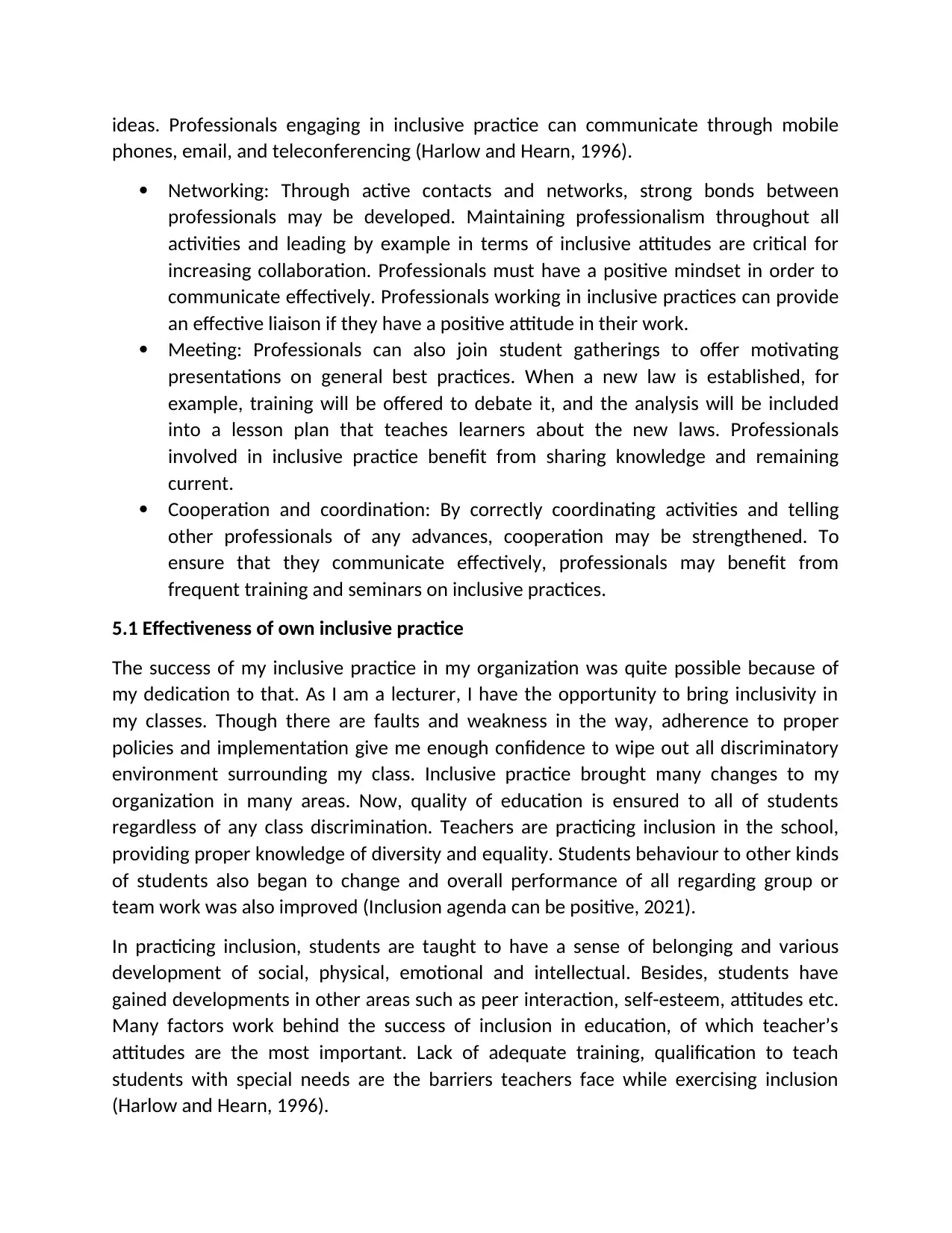
ideas. Professionals engaging in inclusive practice can communicate through mobile
phones, email, and teleconferencing (Harlow and Hearn, 1996).
Networking: Through active contacts and networks, strong bonds between
professionals may be developed. Maintaining professionalism throughout all
activities and leading by example in terms of inclusive attitudes are critical for
increasing collaboration. Professionals must have a positive mindset in order to
communicate effectively. Professionals working in inclusive practices can provide
an effective liaison if they have a positive attitude in their work.
Meeting: Professionals can also join student gatherings to offer motivating
presentations on general best practices. When a new law is established, for
example, training will be offered to debate it, and the analysis will be included
into a lesson plan that teaches learners about the new laws. Professionals
involved in inclusive practice benefit from sharing knowledge and remaining
current.
Cooperation and coordination: By correctly coordinating activities and telling
other professionals of any advances, cooperation may be strengthened. To
ensure that they communicate effectively, professionals may benefit from
frequent training and seminars on inclusive practices.
5.1 Effectiveness of own inclusive practice
The success of my inclusive practice in my organization was quite possible because of
my dedication to that. As I am a lecturer, I have the opportunity to bring inclusivity in
my classes. Though there are faults and weakness in the way, adherence to proper
policies and implementation give me enough confidence to wipe out all discriminatory
environment surrounding my class. Inclusive practice brought many changes to my
organization in many areas. Now, quality of education is ensured to all of students
regardless of any class discrimination. Teachers are practicing inclusion in the school,
providing proper knowledge of diversity and equality. Students behaviour to other kinds
of students also began to change and overall performance of all regarding group or
team work was also improved (Inclusion agenda can be positive, 2021).
In practicing inclusion, students are taught to have a sense of belonging and various
development of social, physical, emotional and intellectual. Besides, students have
gained developments in other areas such as peer interaction, self-esteem, attitudes etc.
Many factors work behind the success of inclusion in education, of which teacher’s
attitudes are the most important. Lack of adequate training, qualification to teach
students with special needs are the barriers teachers face while exercising inclusion
(Harlow and Hearn, 1996).
phones, email, and teleconferencing (Harlow and Hearn, 1996).
Networking: Through active contacts and networks, strong bonds between
professionals may be developed. Maintaining professionalism throughout all
activities and leading by example in terms of inclusive attitudes are critical for
increasing collaboration. Professionals must have a positive mindset in order to
communicate effectively. Professionals working in inclusive practices can provide
an effective liaison if they have a positive attitude in their work.
Meeting: Professionals can also join student gatherings to offer motivating
presentations on general best practices. When a new law is established, for
example, training will be offered to debate it, and the analysis will be included
into a lesson plan that teaches learners about the new laws. Professionals
involved in inclusive practice benefit from sharing knowledge and remaining
current.
Cooperation and coordination: By correctly coordinating activities and telling
other professionals of any advances, cooperation may be strengthened. To
ensure that they communicate effectively, professionals may benefit from
frequent training and seminars on inclusive practices.
5.1 Effectiveness of own inclusive practice
The success of my inclusive practice in my organization was quite possible because of
my dedication to that. As I am a lecturer, I have the opportunity to bring inclusivity in
my classes. Though there are faults and weakness in the way, adherence to proper
policies and implementation give me enough confidence to wipe out all discriminatory
environment surrounding my class. Inclusive practice brought many changes to my
organization in many areas. Now, quality of education is ensured to all of students
regardless of any class discrimination. Teachers are practicing inclusion in the school,
providing proper knowledge of diversity and equality. Students behaviour to other kinds
of students also began to change and overall performance of all regarding group or
team work was also improved (Inclusion agenda can be positive, 2021).
In practicing inclusion, students are taught to have a sense of belonging and various
development of social, physical, emotional and intellectual. Besides, students have
gained developments in other areas such as peer interaction, self-esteem, attitudes etc.
Many factors work behind the success of inclusion in education, of which teacher’s
attitudes are the most important. Lack of adequate training, qualification to teach
students with special needs are the barriers teachers face while exercising inclusion
(Harlow and Hearn, 1996).
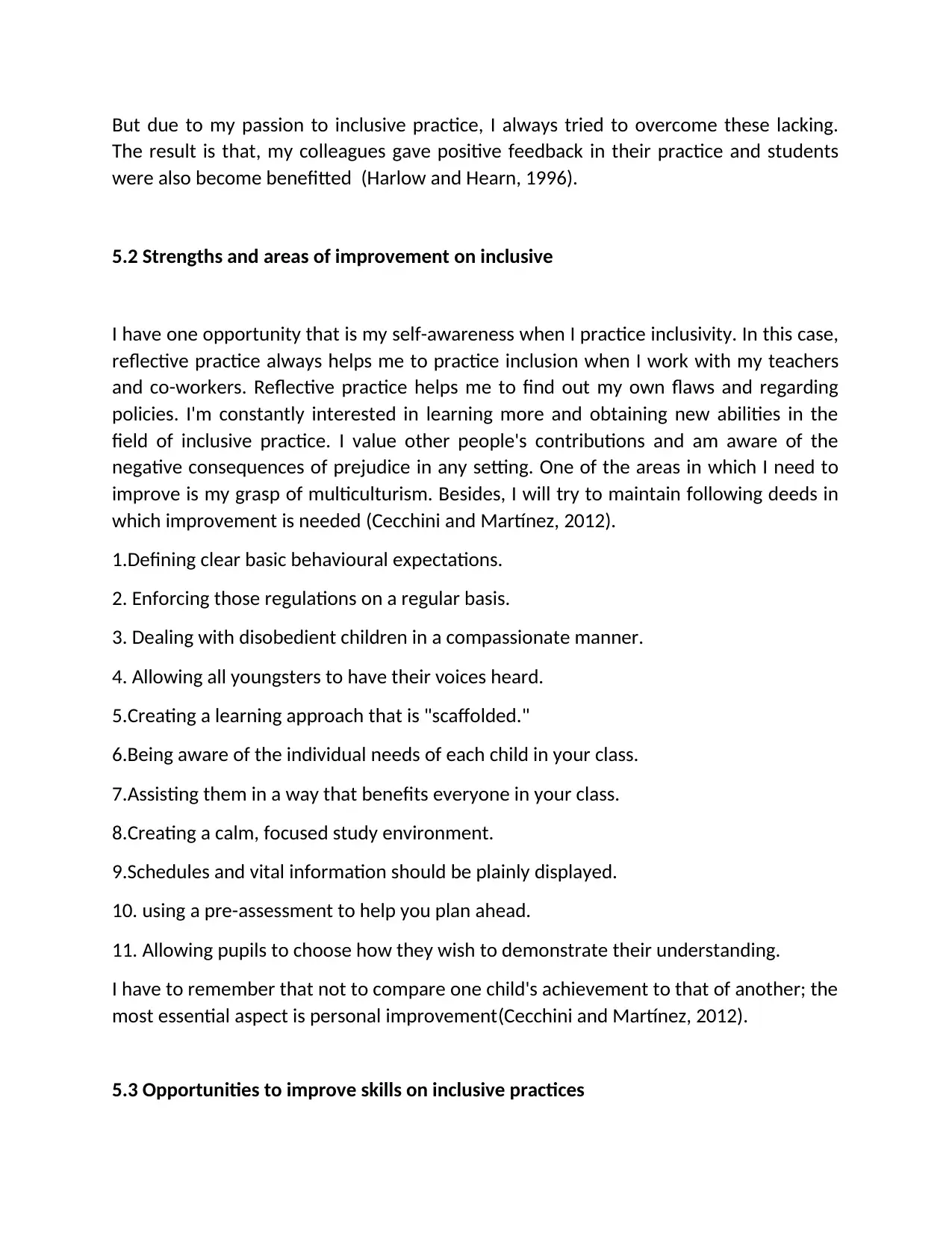
But due to my passion to inclusive practice, I always tried to overcome these lacking.
The result is that, my colleagues gave positive feedback in their practice and students
were also become benefitted (Harlow and Hearn, 1996).
5.2 Strengths and areas of improvement on inclusive
I have one opportunity that is my self-awareness when I practice inclusivity. In this case,
reflective practice always helps me to practice inclusion when I work with my teachers
and co-workers. Reflective practice helps me to find out my own flaws and regarding
policies. I'm constantly interested in learning more and obtaining new abilities in the
field of inclusive practice. I value other people's contributions and am aware of the
negative consequences of prejudice in any setting. One of the areas in which I need to
improve is my grasp of multiculturism. Besides, I will try to maintain following deeds in
which improvement is needed (Cecchini and Martínez, 2012).
1.Defining clear basic behavioural expectations.
2. Enforcing those regulations on a regular basis.
3. Dealing with disobedient children in a compassionate manner.
4. Allowing all youngsters to have their voices heard.
5.Creating a learning approach that is "scaffolded."
6.Being aware of the individual needs of each child in your class.
7.Assisting them in a way that benefits everyone in your class.
8.Creating a calm, focused study environment.
9.Schedules and vital information should be plainly displayed.
10. using a pre-assessment to help you plan ahead.
11. Allowing pupils to choose how they wish to demonstrate their understanding.
I have to remember that not to compare one child's achievement to that of another; the
most essential aspect is personal improvement(Cecchini and Martínez, 2012).
5.3 Opportunities to improve skills on inclusive practices
The result is that, my colleagues gave positive feedback in their practice and students
were also become benefitted (Harlow and Hearn, 1996).
5.2 Strengths and areas of improvement on inclusive
I have one opportunity that is my self-awareness when I practice inclusivity. In this case,
reflective practice always helps me to practice inclusion when I work with my teachers
and co-workers. Reflective practice helps me to find out my own flaws and regarding
policies. I'm constantly interested in learning more and obtaining new abilities in the
field of inclusive practice. I value other people's contributions and am aware of the
negative consequences of prejudice in any setting. One of the areas in which I need to
improve is my grasp of multiculturism. Besides, I will try to maintain following deeds in
which improvement is needed (Cecchini and Martínez, 2012).
1.Defining clear basic behavioural expectations.
2. Enforcing those regulations on a regular basis.
3. Dealing with disobedient children in a compassionate manner.
4. Allowing all youngsters to have their voices heard.
5.Creating a learning approach that is "scaffolded."
6.Being aware of the individual needs of each child in your class.
7.Assisting them in a way that benefits everyone in your class.
8.Creating a calm, focused study environment.
9.Schedules and vital information should be plainly displayed.
10. using a pre-assessment to help you plan ahead.
11. Allowing pupils to choose how they wish to demonstrate their understanding.
I have to remember that not to compare one child's achievement to that of another; the
most essential aspect is personal improvement(Cecchini and Martínez, 2012).
5.3 Opportunities to improve skills on inclusive practices
Paraphrase This Document
Need a fresh take? Get an instant paraphrase of this document with our AI Paraphraser
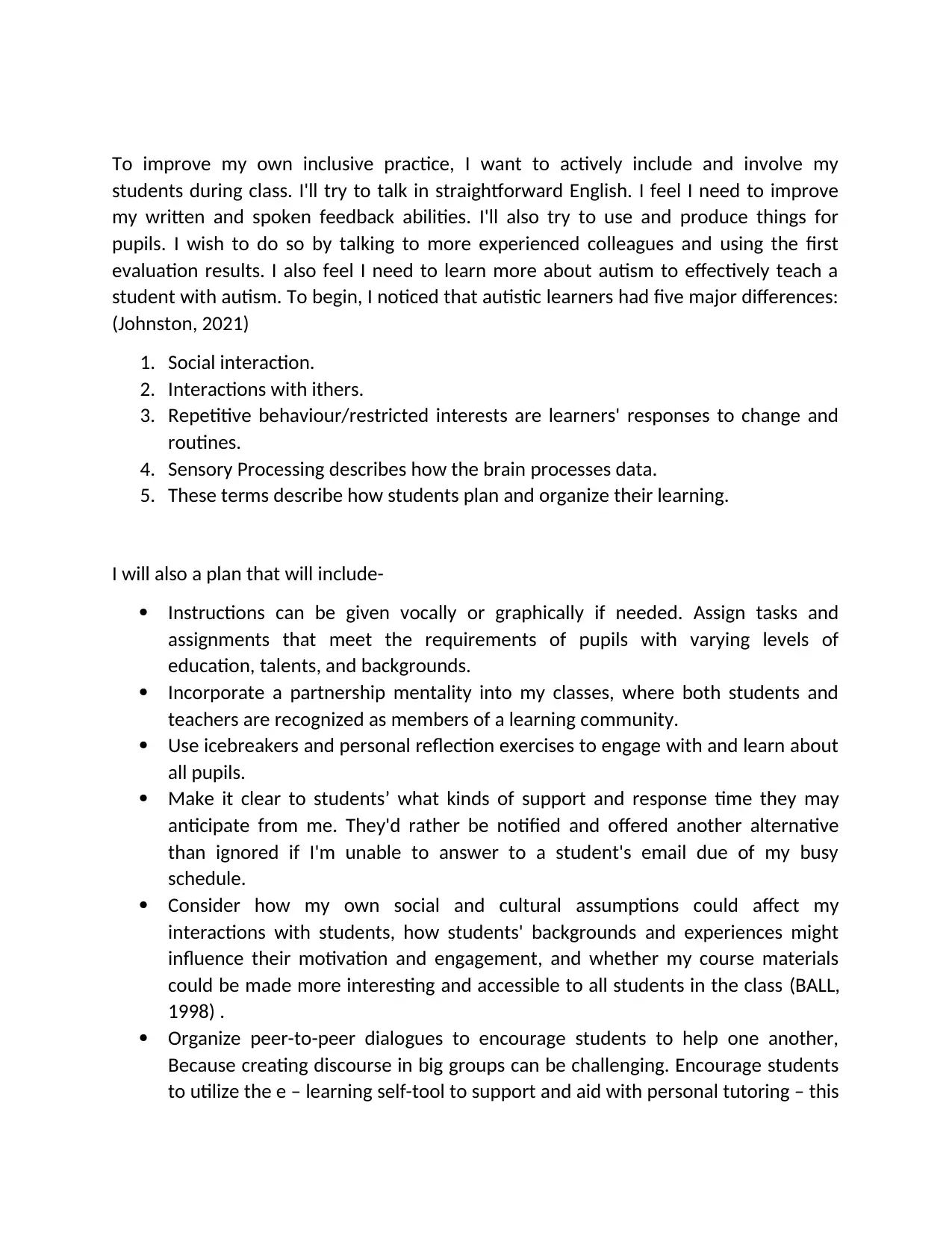
To improve my own inclusive practice, I want to actively include and involve my
students during class. I'll try to talk in straightforward English. I feel I need to improve
my written and spoken feedback abilities. I'll also try to use and produce things for
pupils. I wish to do so by talking to more experienced colleagues and using the first
evaluation results. I also feel I need to learn more about autism to effectively teach a
student with autism. To begin, I noticed that autistic learners had five major differences:
(Johnston, 2021)
1. Social interaction.
2. Interactions with ithers.
3. Repetitive behaviour/restricted interests are learners' responses to change and
routines.
4. Sensory Processing describes how the brain processes data.
5. These terms describe how students plan and organize their learning.
I will also a plan that will include-
Instructions can be given vocally or graphically if needed. Assign tasks and
assignments that meet the requirements of pupils with varying levels of
education, talents, and backgrounds.
Incorporate a partnership mentality into my classes, where both students and
teachers are recognized as members of a learning community.
Use icebreakers and personal reflection exercises to engage with and learn about
all pupils.
Make it clear to students’ what kinds of support and response time they may
anticipate from me. They'd rather be notified and offered another alternative
than ignored if I'm unable to answer to a student's email due of my busy
schedule.
Consider how my own social and cultural assumptions could affect my
interactions with students, how students' backgrounds and experiences might
influence their motivation and engagement, and whether my course materials
could be made more interesting and accessible to all students in the class (BALL,
1998) .
Organize peer-to-peer dialogues to encourage students to help one another,
Because creating discourse in big groups can be challenging. Encourage students
to utilize the e – learning self-tool to support and aid with personal tutoring – this
students during class. I'll try to talk in straightforward English. I feel I need to improve
my written and spoken feedback abilities. I'll also try to use and produce things for
pupils. I wish to do so by talking to more experienced colleagues and using the first
evaluation results. I also feel I need to learn more about autism to effectively teach a
student with autism. To begin, I noticed that autistic learners had five major differences:
(Johnston, 2021)
1. Social interaction.
2. Interactions with ithers.
3. Repetitive behaviour/restricted interests are learners' responses to change and
routines.
4. Sensory Processing describes how the brain processes data.
5. These terms describe how students plan and organize their learning.
I will also a plan that will include-
Instructions can be given vocally or graphically if needed. Assign tasks and
assignments that meet the requirements of pupils with varying levels of
education, talents, and backgrounds.
Incorporate a partnership mentality into my classes, where both students and
teachers are recognized as members of a learning community.
Use icebreakers and personal reflection exercises to engage with and learn about
all pupils.
Make it clear to students’ what kinds of support and response time they may
anticipate from me. They'd rather be notified and offered another alternative
than ignored if I'm unable to answer to a student's email due of my busy
schedule.
Consider how my own social and cultural assumptions could affect my
interactions with students, how students' backgrounds and experiences might
influence their motivation and engagement, and whether my course materials
could be made more interesting and accessible to all students in the class (BALL,
1998) .
Organize peer-to-peer dialogues to encourage students to help one another,
Because creating discourse in big groups can be challenging. Encourage students
to utilize the e – learning self-tool to support and aid with personal tutoring – this
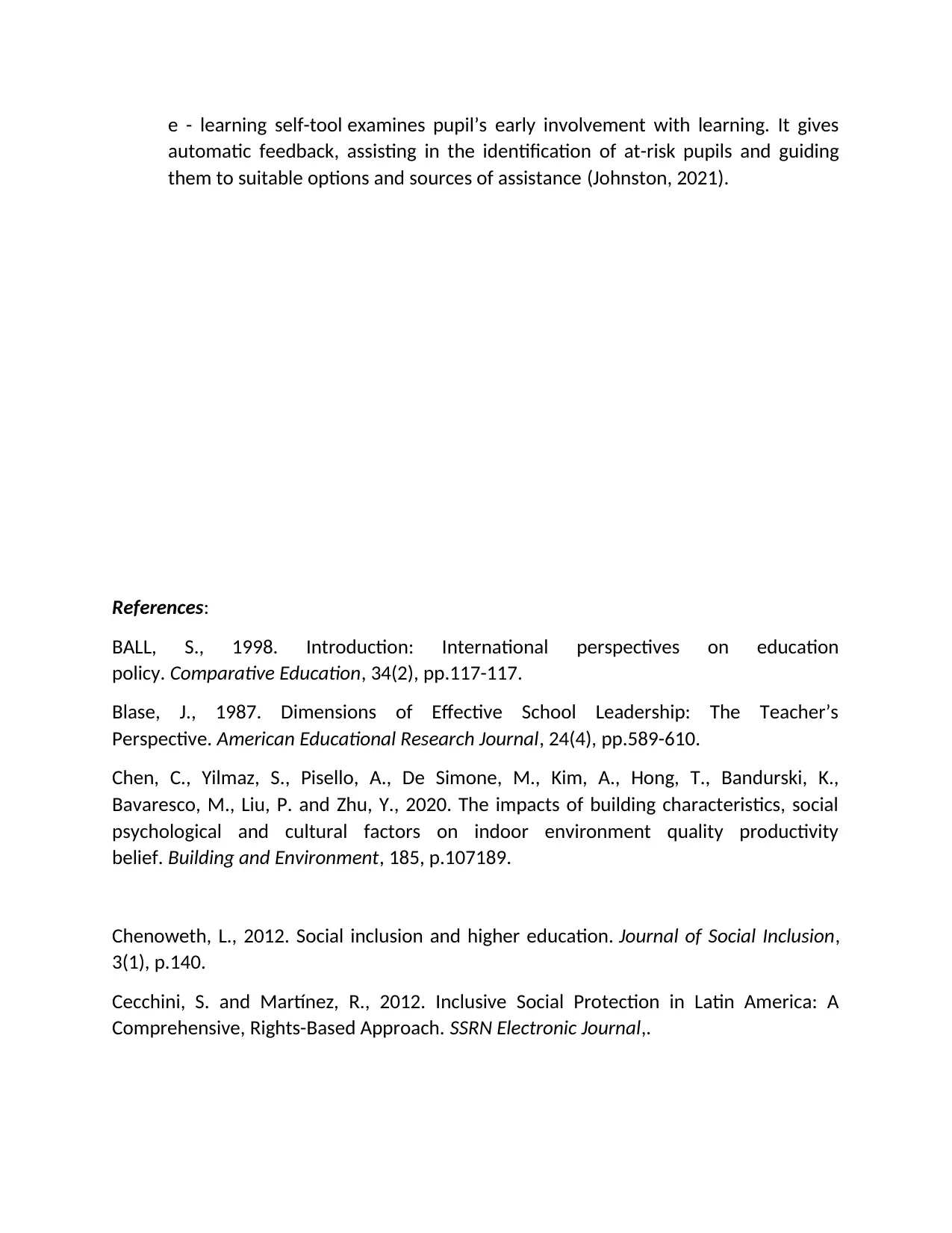
e - learning self-tool examines pupil’s early involvement with learning. It gives
automatic feedback, assisting in the identification of at-risk pupils and guiding
them to suitable options and sources of assistance (Johnston, 2021).
References:
BALL, S., 1998. Introduction: International perspectives on education
policy. Comparative Education, 34(2), pp.117-117.
Blase, J., 1987. Dimensions of Effective School Leadership: The Teacher’s
Perspective. American Educational Research Journal, 24(4), pp.589-610.
Chen, C., Yilmaz, S., Pisello, A., De Simone, M., Kim, A., Hong, T., Bandurski, K.,
Bavaresco, M., Liu, P. and Zhu, Y., 2020. The impacts of building characteristics, social
psychological and cultural factors on indoor environment quality productivity
belief. Building and Environment, 185, p.107189.
Chenoweth, L., 2012. Social inclusion and higher education. Journal of Social Inclusion,
3(1), p.140.
Cecchini, S. and Martínez, R., 2012. Inclusive Social Protection in Latin America: A
Comprehensive, Rights-Based Approach. SSRN Electronic Journal,.
automatic feedback, assisting in the identification of at-risk pupils and guiding
them to suitable options and sources of assistance (Johnston, 2021).
References:
BALL, S., 1998. Introduction: International perspectives on education
policy. Comparative Education, 34(2), pp.117-117.
Blase, J., 1987. Dimensions of Effective School Leadership: The Teacher’s
Perspective. American Educational Research Journal, 24(4), pp.589-610.
Chen, C., Yilmaz, S., Pisello, A., De Simone, M., Kim, A., Hong, T., Bandurski, K.,
Bavaresco, M., Liu, P. and Zhu, Y., 2020. The impacts of building characteristics, social
psychological and cultural factors on indoor environment quality productivity
belief. Building and Environment, 185, p.107189.
Chenoweth, L., 2012. Social inclusion and higher education. Journal of Social Inclusion,
3(1), p.140.
Cecchini, S. and Martínez, R., 2012. Inclusive Social Protection in Latin America: A
Comprehensive, Rights-Based Approach. SSRN Electronic Journal,.
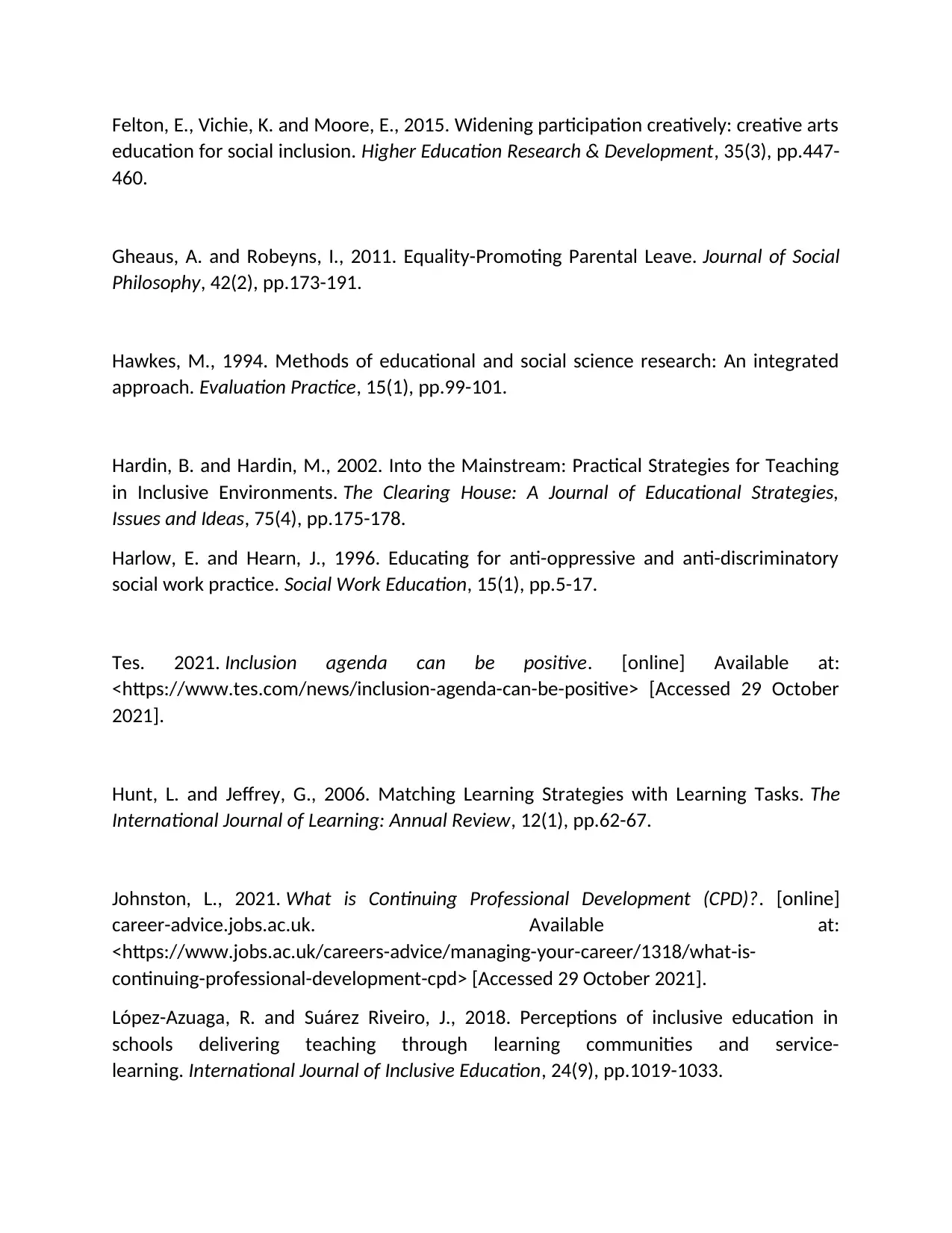
Felton, E., Vichie, K. and Moore, E., 2015. Widening participation creatively: creative arts
education for social inclusion. Higher Education Research & Development, 35(3), pp.447-
460.
Gheaus, A. and Robeyns, I., 2011. Equality-Promoting Parental Leave. Journal of Social
Philosophy, 42(2), pp.173-191.
Hawkes, M., 1994. Methods of educational and social science research: An integrated
approach. Evaluation Practice, 15(1), pp.99-101.
Hardin, B. and Hardin, M., 2002. Into the Mainstream: Practical Strategies for Teaching
in Inclusive Environments. The Clearing House: A Journal of Educational Strategies,
Issues and Ideas, 75(4), pp.175-178.
Harlow, E. and Hearn, J., 1996. Educating for anti-oppressive and anti-discriminatory
social work practice. Social Work Education, 15(1), pp.5-17.
Tes. 2021. Inclusion agenda can be positive. [online] Available at:
<https://www.tes.com/news/inclusion-agenda-can-be-positive> [Accessed 29 October
2021].
Hunt, L. and Jeffrey, G., 2006. Matching Learning Strategies with Learning Tasks. The
International Journal of Learning: Annual Review, 12(1), pp.62-67.
Johnston, L., 2021. What is Continuing Professional Development (CPD)?. [online]
career-advice.jobs.ac.uk. Available at:
<https://www.jobs.ac.uk/careers-advice/managing-your-career/1318/what-is-
continuing-professional-development-cpd> [Accessed 29 October 2021].
López-Azuaga, R. and Suárez Riveiro, J., 2018. Perceptions of inclusive education in
schools delivering teaching through learning communities and service-
learning. International Journal of Inclusive Education, 24(9), pp.1019-1033.
education for social inclusion. Higher Education Research & Development, 35(3), pp.447-
460.
Gheaus, A. and Robeyns, I., 2011. Equality-Promoting Parental Leave. Journal of Social
Philosophy, 42(2), pp.173-191.
Hawkes, M., 1994. Methods of educational and social science research: An integrated
approach. Evaluation Practice, 15(1), pp.99-101.
Hardin, B. and Hardin, M., 2002. Into the Mainstream: Practical Strategies for Teaching
in Inclusive Environments. The Clearing House: A Journal of Educational Strategies,
Issues and Ideas, 75(4), pp.175-178.
Harlow, E. and Hearn, J., 1996. Educating for anti-oppressive and anti-discriminatory
social work practice. Social Work Education, 15(1), pp.5-17.
Tes. 2021. Inclusion agenda can be positive. [online] Available at:
<https://www.tes.com/news/inclusion-agenda-can-be-positive> [Accessed 29 October
2021].
Hunt, L. and Jeffrey, G., 2006. Matching Learning Strategies with Learning Tasks. The
International Journal of Learning: Annual Review, 12(1), pp.62-67.
Johnston, L., 2021. What is Continuing Professional Development (CPD)?. [online]
career-advice.jobs.ac.uk. Available at:
<https://www.jobs.ac.uk/careers-advice/managing-your-career/1318/what-is-
continuing-professional-development-cpd> [Accessed 29 October 2021].
López-Azuaga, R. and Suárez Riveiro, J., 2018. Perceptions of inclusive education in
schools delivering teaching through learning communities and service-
learning. International Journal of Inclusive Education, 24(9), pp.1019-1033.
Secure Best Marks with AI Grader
Need help grading? Try our AI Grader for instant feedback on your assignments.
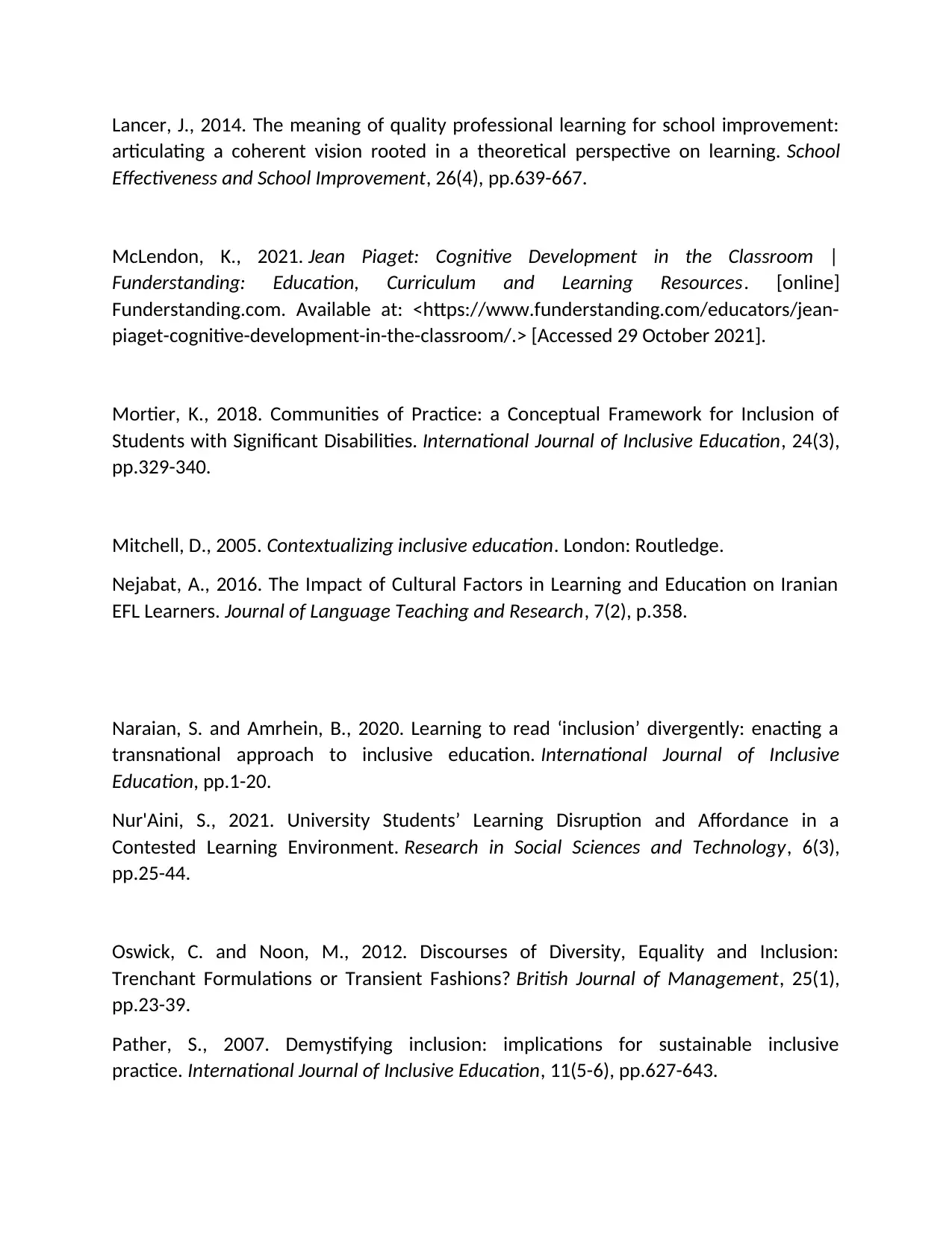
Lancer, J., 2014. The meaning of quality professional learning for school improvement:
articulating a coherent vision rooted in a theoretical perspective on learning. School
Effectiveness and School Improvement, 26(4), pp.639-667.
McLendon, K., 2021. Jean Piaget: Cognitive Development in the Classroom |
Funderstanding: Education, Curriculum and Learning Resources. [online]
Funderstanding.com. Available at: <https://www.funderstanding.com/educators/jean-
piaget-cognitive-development-in-the-classroom/.> [Accessed 29 October 2021].
Mortier, K., 2018. Communities of Practice: a Conceptual Framework for Inclusion of
Students with Significant Disabilities. International Journal of Inclusive Education, 24(3),
pp.329-340.
Mitchell, D., 2005. Contextualizing inclusive education. London: Routledge.
Nejabat, A., 2016. The Impact of Cultural Factors in Learning and Education on Iranian
EFL Learners. Journal of Language Teaching and Research, 7(2), p.358.
Naraian, S. and Amrhein, B., 2020. Learning to read ‘inclusion’ divergently: enacting a
transnational approach to inclusive education. International Journal of Inclusive
Education, pp.1-20.
Nur'Aini, S., 2021. University Students’ Learning Disruption and Affordance in a
Contested Learning Environment. Research in Social Sciences and Technology, 6(3),
pp.25-44.
Oswick, C. and Noon, M., 2012. Discourses of Diversity, Equality and Inclusion:
Trenchant Formulations or Transient Fashions? British Journal of Management, 25(1),
pp.23-39.
Pather, S., 2007. Demystifying inclusion: implications for sustainable inclusive
practice. International Journal of Inclusive Education, 11(5-6), pp.627-643.
articulating a coherent vision rooted in a theoretical perspective on learning. School
Effectiveness and School Improvement, 26(4), pp.639-667.
McLendon, K., 2021. Jean Piaget: Cognitive Development in the Classroom |
Funderstanding: Education, Curriculum and Learning Resources. [online]
Funderstanding.com. Available at: <https://www.funderstanding.com/educators/jean-
piaget-cognitive-development-in-the-classroom/.> [Accessed 29 October 2021].
Mortier, K., 2018. Communities of Practice: a Conceptual Framework for Inclusion of
Students with Significant Disabilities. International Journal of Inclusive Education, 24(3),
pp.329-340.
Mitchell, D., 2005. Contextualizing inclusive education. London: Routledge.
Nejabat, A., 2016. The Impact of Cultural Factors in Learning and Education on Iranian
EFL Learners. Journal of Language Teaching and Research, 7(2), p.358.
Naraian, S. and Amrhein, B., 2020. Learning to read ‘inclusion’ divergently: enacting a
transnational approach to inclusive education. International Journal of Inclusive
Education, pp.1-20.
Nur'Aini, S., 2021. University Students’ Learning Disruption and Affordance in a
Contested Learning Environment. Research in Social Sciences and Technology, 6(3),
pp.25-44.
Oswick, C. and Noon, M., 2012. Discourses of Diversity, Equality and Inclusion:
Trenchant Formulations or Transient Fashions? British Journal of Management, 25(1),
pp.23-39.
Pather, S., 2007. Demystifying inclusion: implications for sustainable inclusive
practice. International Journal of Inclusive Education, 11(5-6), pp.627-643.
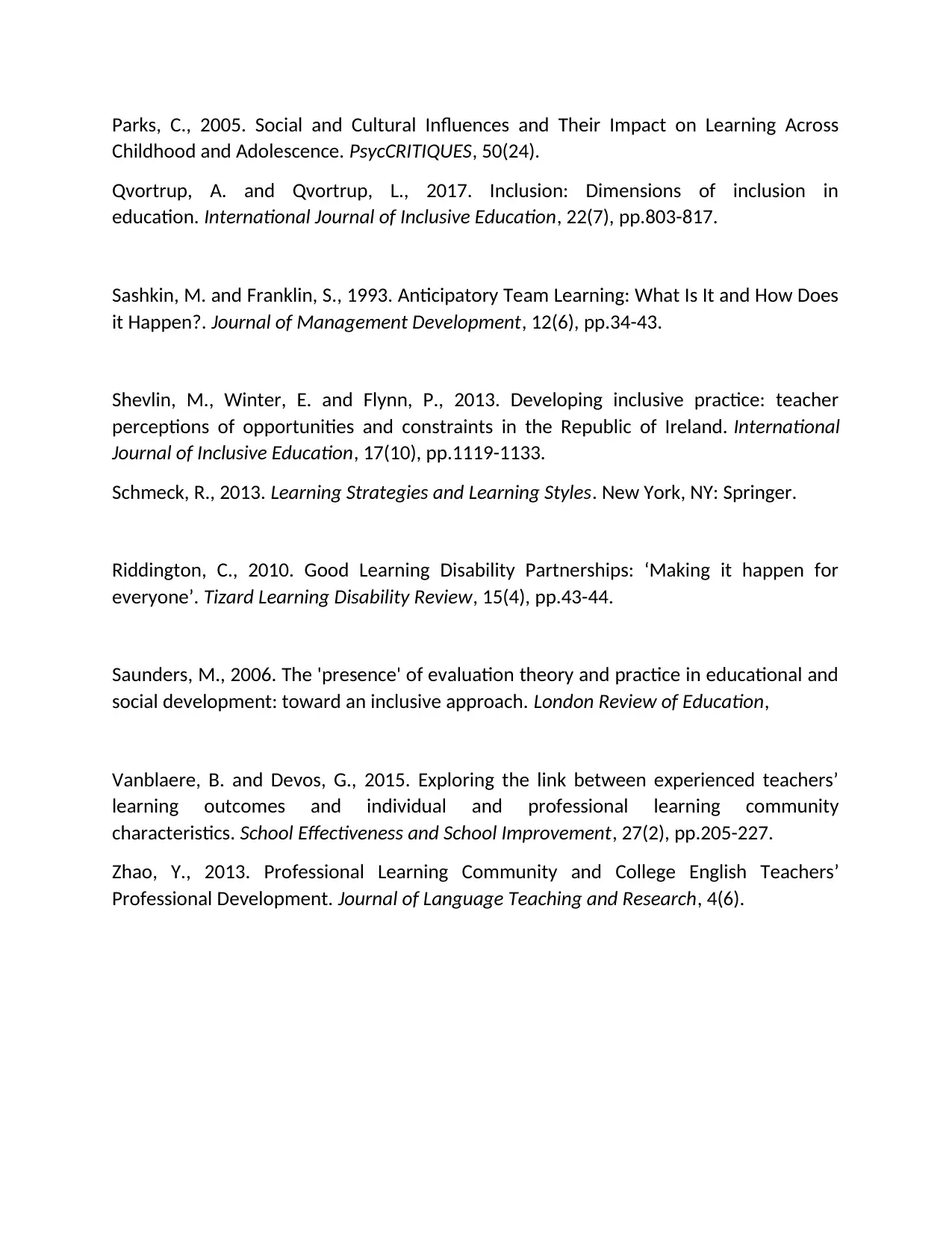
Parks, C., 2005. Social and Cultural Influences and Their Impact on Learning Across
Childhood and Adolescence. PsycCRITIQUES, 50(24).
Qvortrup, A. and Qvortrup, L., 2017. Inclusion: Dimensions of inclusion in
education. International Journal of Inclusive Education, 22(7), pp.803-817.
Sashkin, M. and Franklin, S., 1993. Anticipatory Team Learning: What Is It and How Does
it Happen?. Journal of Management Development, 12(6), pp.34-43.
Shevlin, M., Winter, E. and Flynn, P., 2013. Developing inclusive practice: teacher
perceptions of opportunities and constraints in the Republic of Ireland. International
Journal of Inclusive Education, 17(10), pp.1119-1133.
Schmeck, R., 2013. Learning Strategies and Learning Styles. New York, NY: Springer.
Riddington, C., 2010. Good Learning Disability Partnerships: ‘Making it happen for
everyone’. Tizard Learning Disability Review, 15(4), pp.43-44.
Saunders, M., 2006. The 'presence' of evaluation theory and practice in educational and
social development: toward an inclusive approach. London Review of Education,
Vanblaere, B. and Devos, G., 2015. Exploring the link between experienced teachers’
learning outcomes and individual and professional learning community
characteristics. School Effectiveness and School Improvement, 27(2), pp.205-227.
Zhao, Y., 2013. Professional Learning Community and College English Teachers’
Professional Development. Journal of Language Teaching and Research, 4(6).
Childhood and Adolescence. PsycCRITIQUES, 50(24).
Qvortrup, A. and Qvortrup, L., 2017. Inclusion: Dimensions of inclusion in
education. International Journal of Inclusive Education, 22(7), pp.803-817.
Sashkin, M. and Franklin, S., 1993. Anticipatory Team Learning: What Is It and How Does
it Happen?. Journal of Management Development, 12(6), pp.34-43.
Shevlin, M., Winter, E. and Flynn, P., 2013. Developing inclusive practice: teacher
perceptions of opportunities and constraints in the Republic of Ireland. International
Journal of Inclusive Education, 17(10), pp.1119-1133.
Schmeck, R., 2013. Learning Strategies and Learning Styles. New York, NY: Springer.
Riddington, C., 2010. Good Learning Disability Partnerships: ‘Making it happen for
everyone’. Tizard Learning Disability Review, 15(4), pp.43-44.
Saunders, M., 2006. The 'presence' of evaluation theory and practice in educational and
social development: toward an inclusive approach. London Review of Education,
Vanblaere, B. and Devos, G., 2015. Exploring the link between experienced teachers’
learning outcomes and individual and professional learning community
characteristics. School Effectiveness and School Improvement, 27(2), pp.205-227.
Zhao, Y., 2013. Professional Learning Community and College English Teachers’
Professional Development. Journal of Language Teaching and Research, 4(6).
1 out of 18
Related Documents
Your All-in-One AI-Powered Toolkit for Academic Success.
+13062052269
info@desklib.com
Available 24*7 on WhatsApp / Email
![[object Object]](/_next/static/media/star-bottom.7253800d.svg)
Unlock your academic potential
© 2024 | Zucol Services PVT LTD | All rights reserved.





